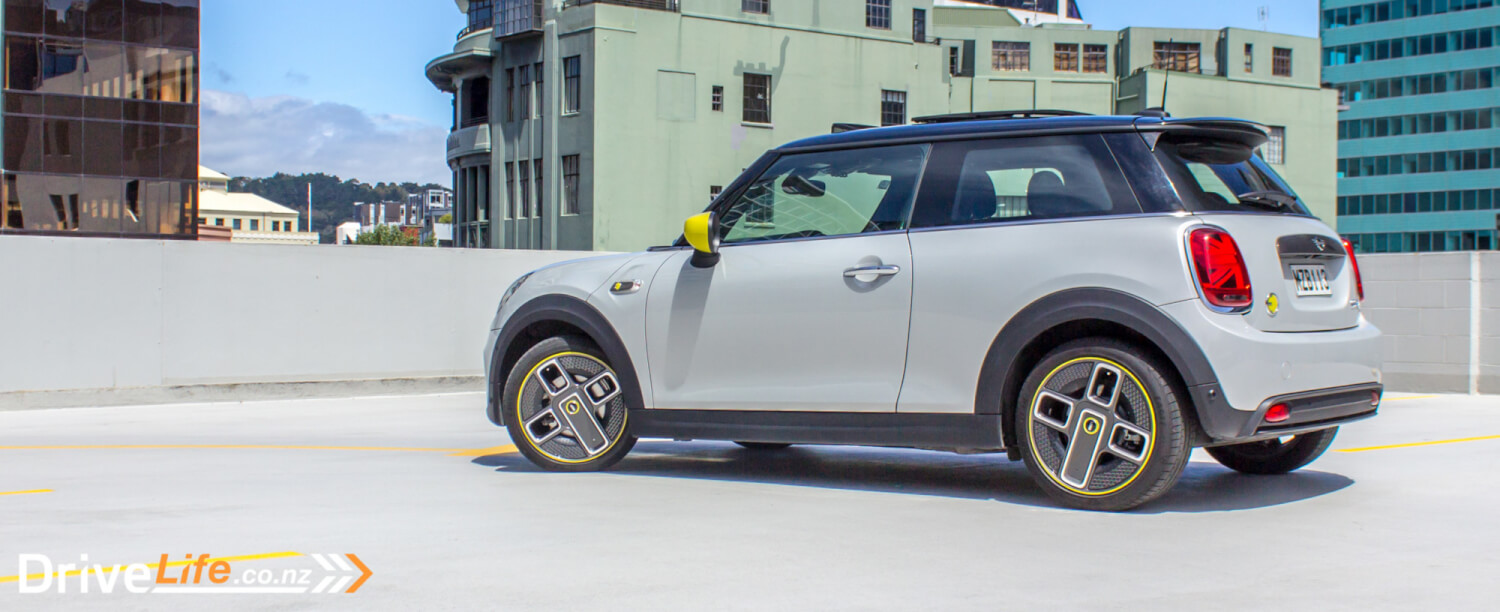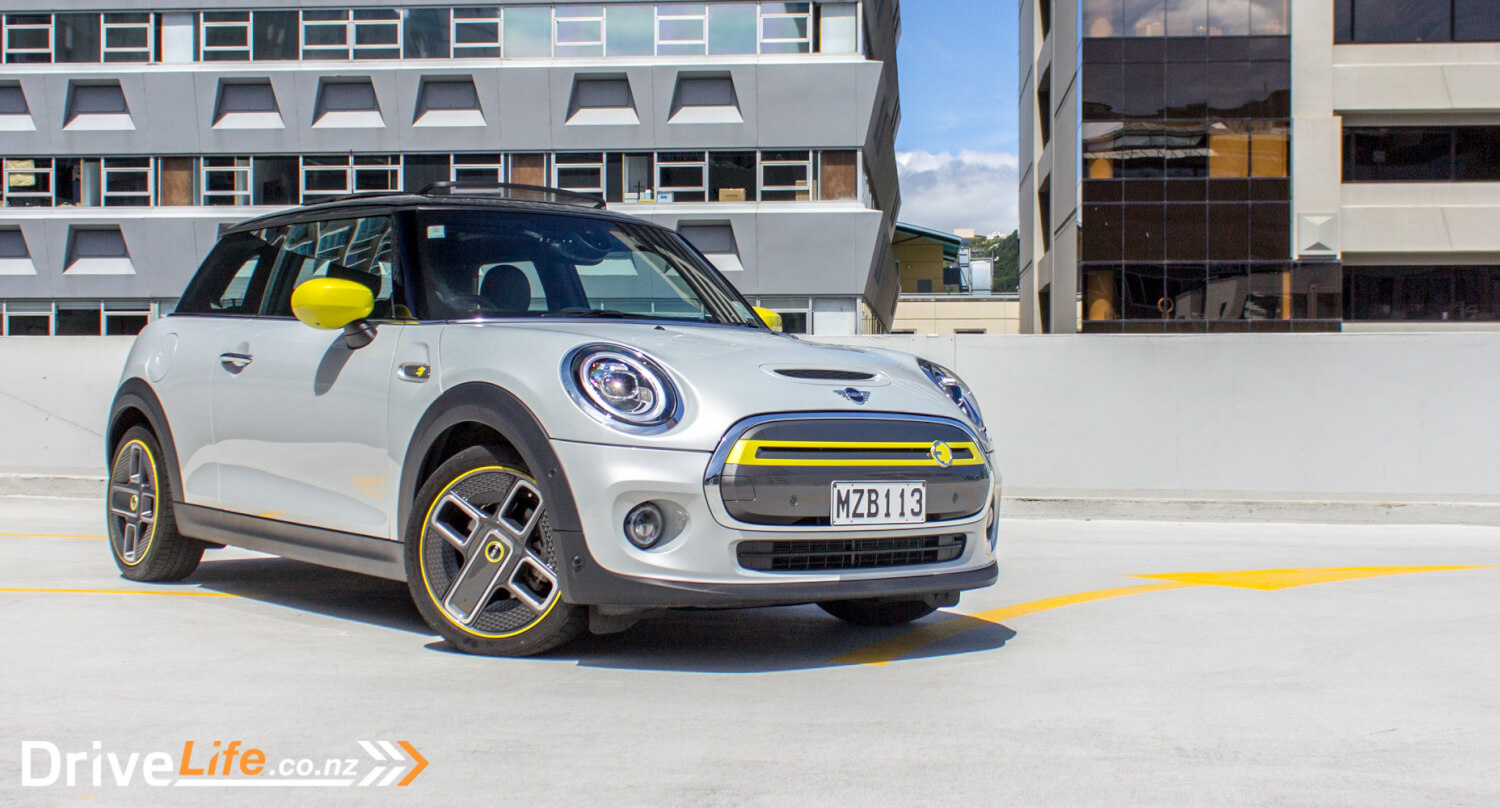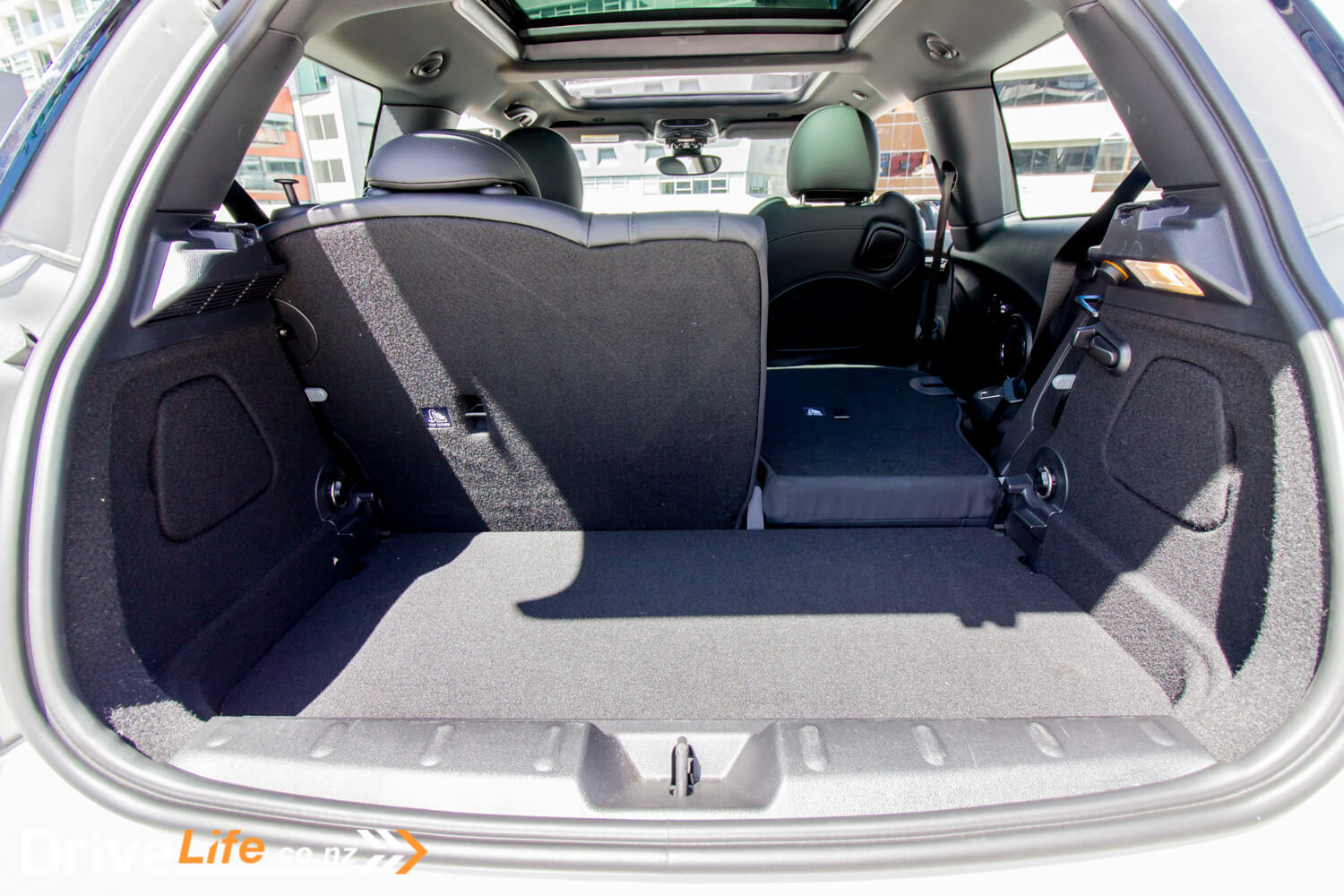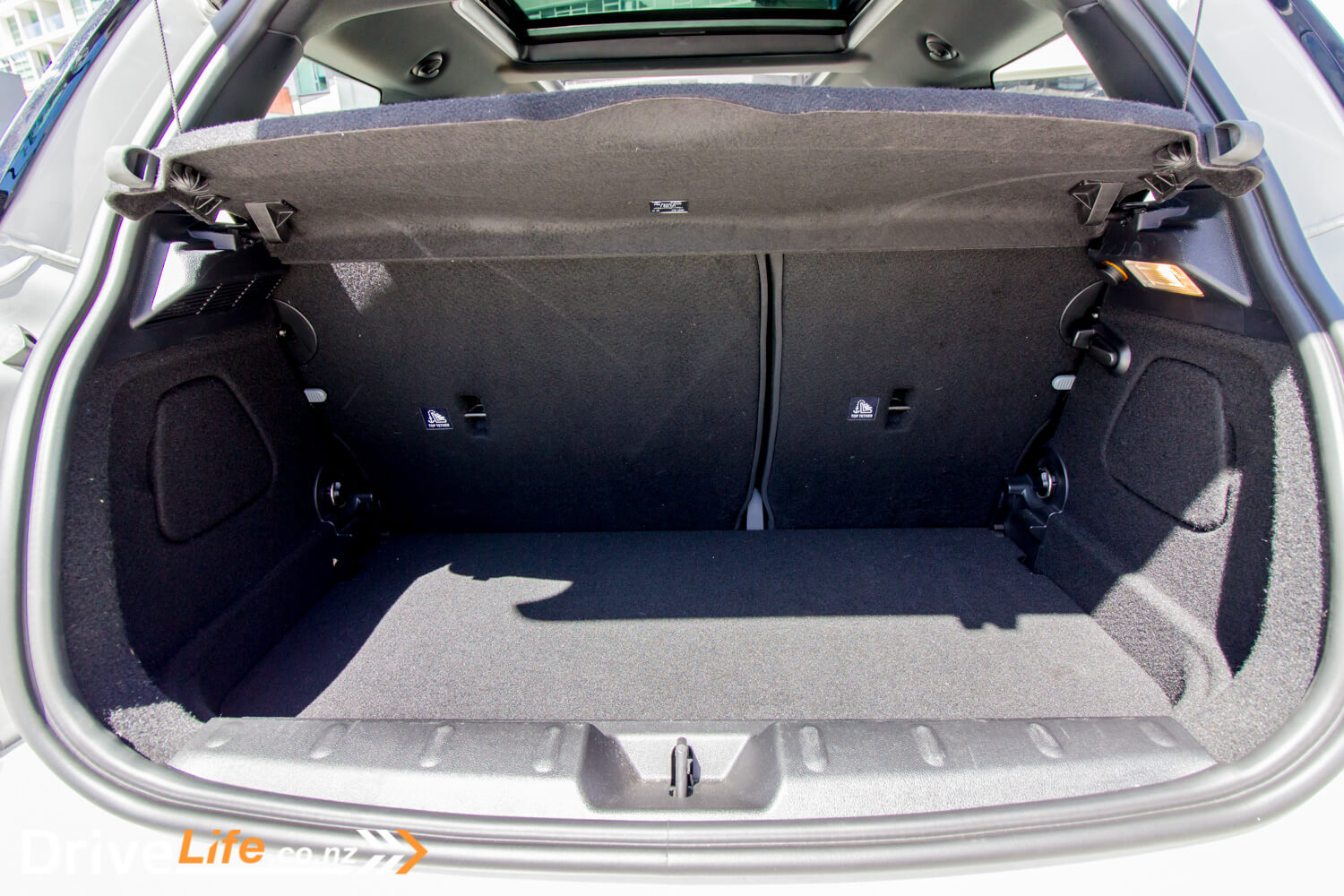The MINI Electric might seem like a new model, where some time will be spent making it better, ironing out bugs. But that’s not the case; using the electric drive system from the BMW i3, the MINI Electric should be pretty well sorted out of the box.
However, it does have a smaller capacity battery than the i3, at 32.6kWh (the i3 is 42kWh), and there’s no Range Extender option either. Does this mean the MINI Electric shouldn’t be on your list, if you are considering moving to an EV that is designed for city use?
MINI sent us one three weeks over Christmas to see if it could roll with the big boys.
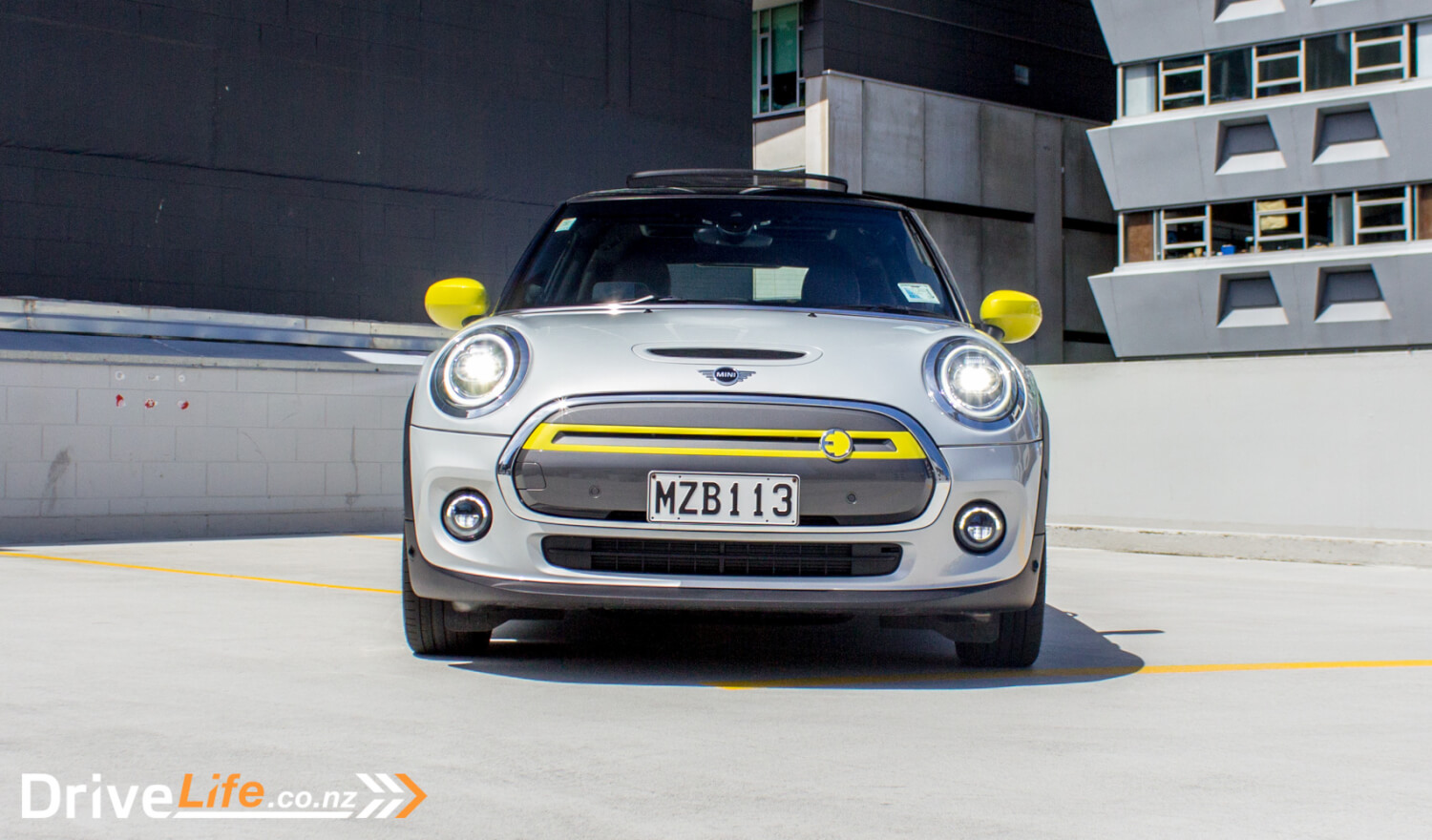
What’s In The 2020 MINI Cooper SE Electric Range?
The UK-built MINI Electric comes in just the one flavour: the $59,990 Cooper SE. Actually, the MINI Electric is built at the birthplace and heart of MINI production, in Oxford, England. It’s front-wheel-drive only, with the electric engine up there of course, while the batteries are mounted in a T-shape under the floorpan.
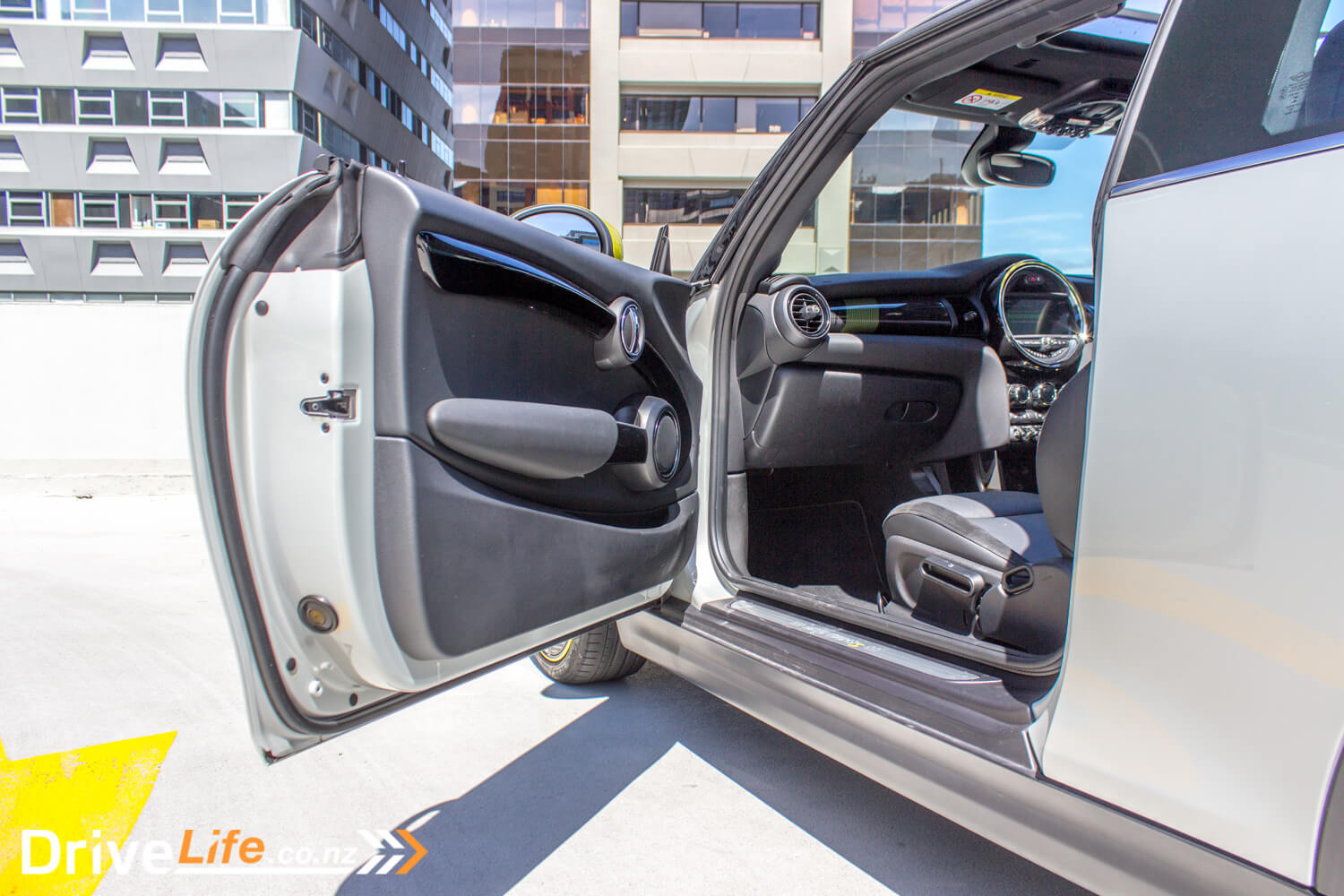
There is the Countryman available as well, but since that’s a plug-in hybrid, we’re ignoring it for this review. The electric engine manages 135kW of power, and 270Nm of torque – good figures for a 1,365Kg car.
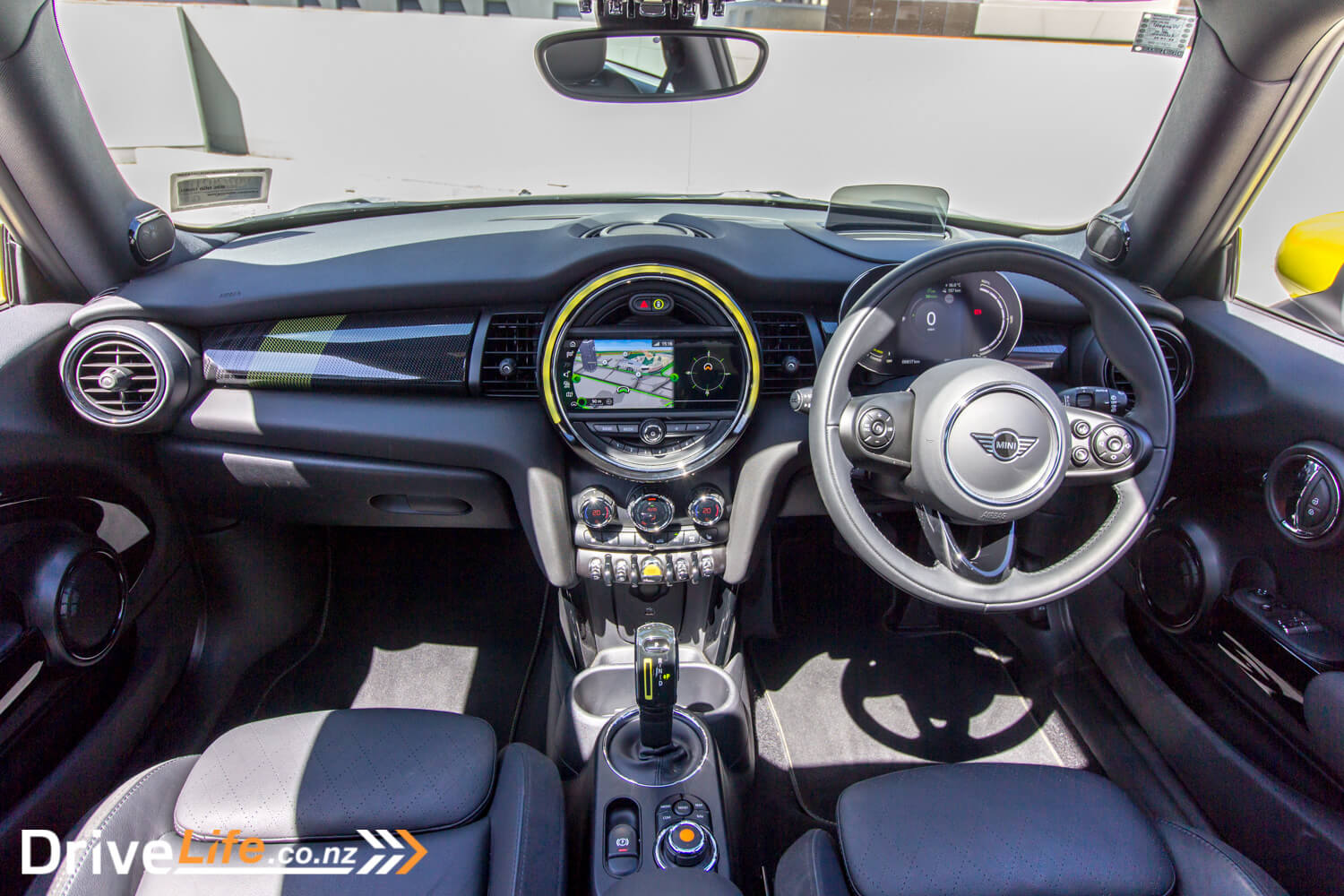
The MINI Electric is closest in specs to the Cooper S, but does add some extra equipment, like a digital TFT LCD instrument cluster, a 12-speaker Harmon Kardon sound system and a heads-up display.
From the Cooper S, it takes heated front seats, adaptive LED headlights, Apple CarPlay and Android Auto, leather seating, 17” alloy wheels, SatNav with Real Time Traffic Information, MINI Connected Services, Comfort Access, adaptive LED headlights, heads-up display, front and rear parking sensors including Parking Assistant, Qi wireless phone charging, electric park brake, keyless entry and start, City Crash Mitigation with pedestrian detection, reversing camera with dynamic guidelines, cruise control, speed limiter, front LED fog lights, rear fog light, auto high beams, auto wipers, LED interior light pack, heated exterior mirrors and washer jets, ambient lighting, MINI logo projection from the doors, dual zone climate AC, and wireless Apple CarPlay.
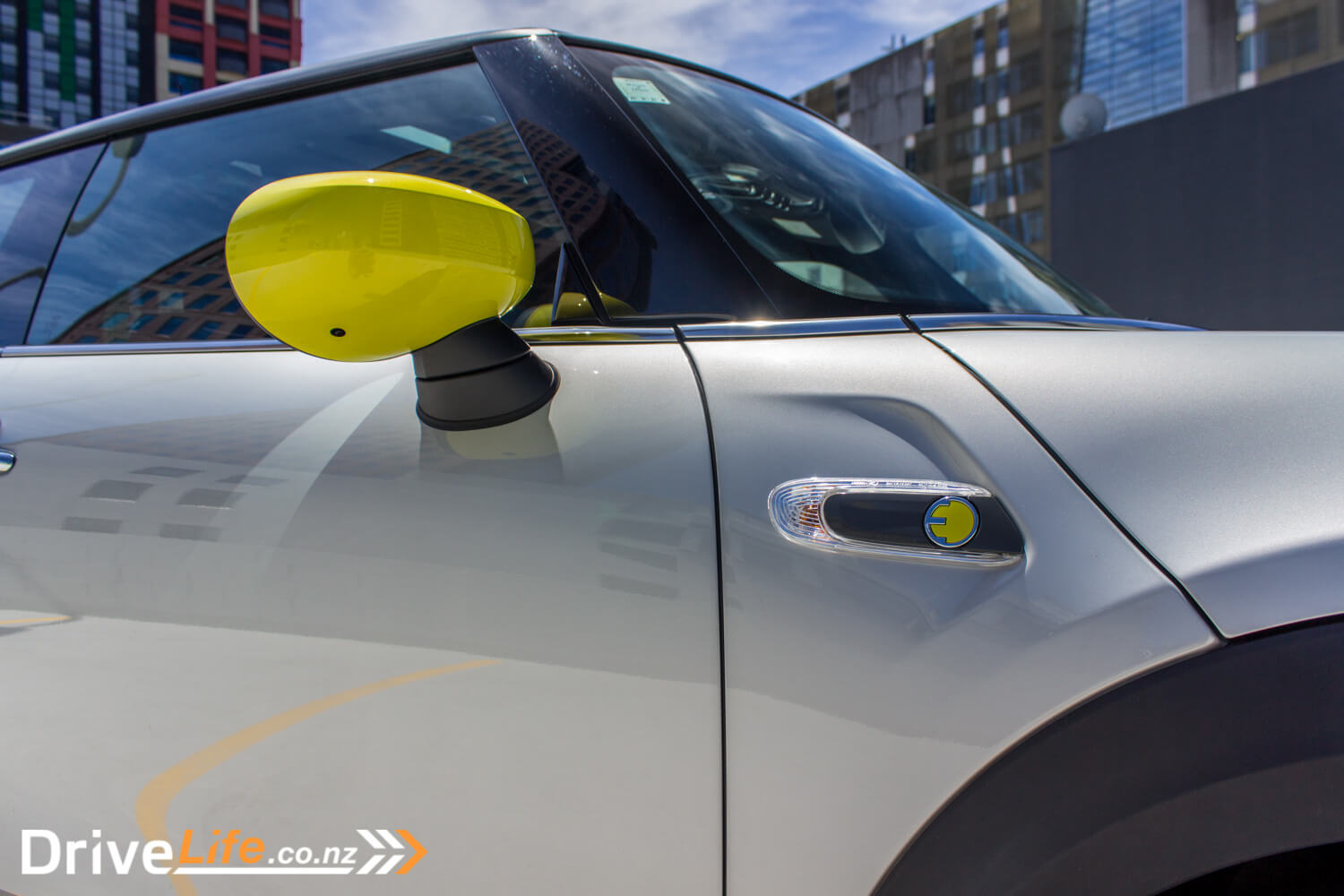
Our test car did come with a double sunroof, which isn’t actually available on New Zealand-spec models.
The MINI Electric is $6,000 more than the equivalent petrol-powered MINI Cooper S. Compared to say a Hyundai Kona EV which is double the cost of the petrol equivalent, the MINI Electric is good value.
There’s four colour combinations available, which includes different wheel options as well, namley 17-inch MINI Electric Power Spoke wheels paired to White Silver and Midnight Black, or 17-inch MINI Tentacle Spoke wheels paired to Chili Red and British Racing Green. The changes in wheels also goes to the colour of the mirror caps and front blade.
You can read more about the MINI Electric on MINI New Zealand’s website.
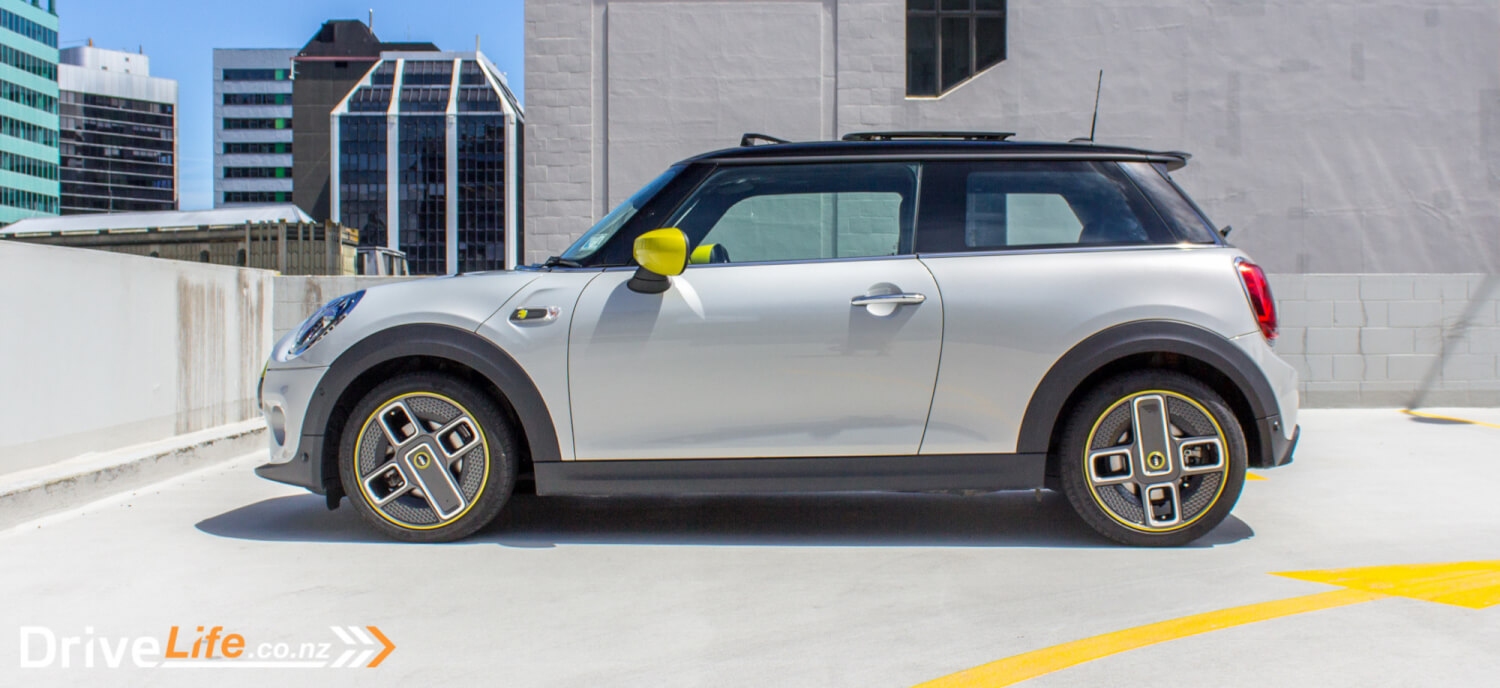
First Impressions Of The 2020 MINI Cooper SE Electric Hatch
“However it happens, our task will be to make a MINI recognisable as a MINI,” says Oliver Heilmer, Head of Design for MINI. Well, they’ve achieved that and also managed to not make the car look too weird and scare off potential buyers.
There’s a few features that point to the car not being a petrol-powered MINI; the covering of the grille with a big-ass piece of plastic is one, you’ll certainly notice the different wheels, and a few EV-looking badges on the sides and rear of the car. There’s also some yellow mirror caps as standard, and the familiar Union Jack tail lights which admittedly look very cool at night.
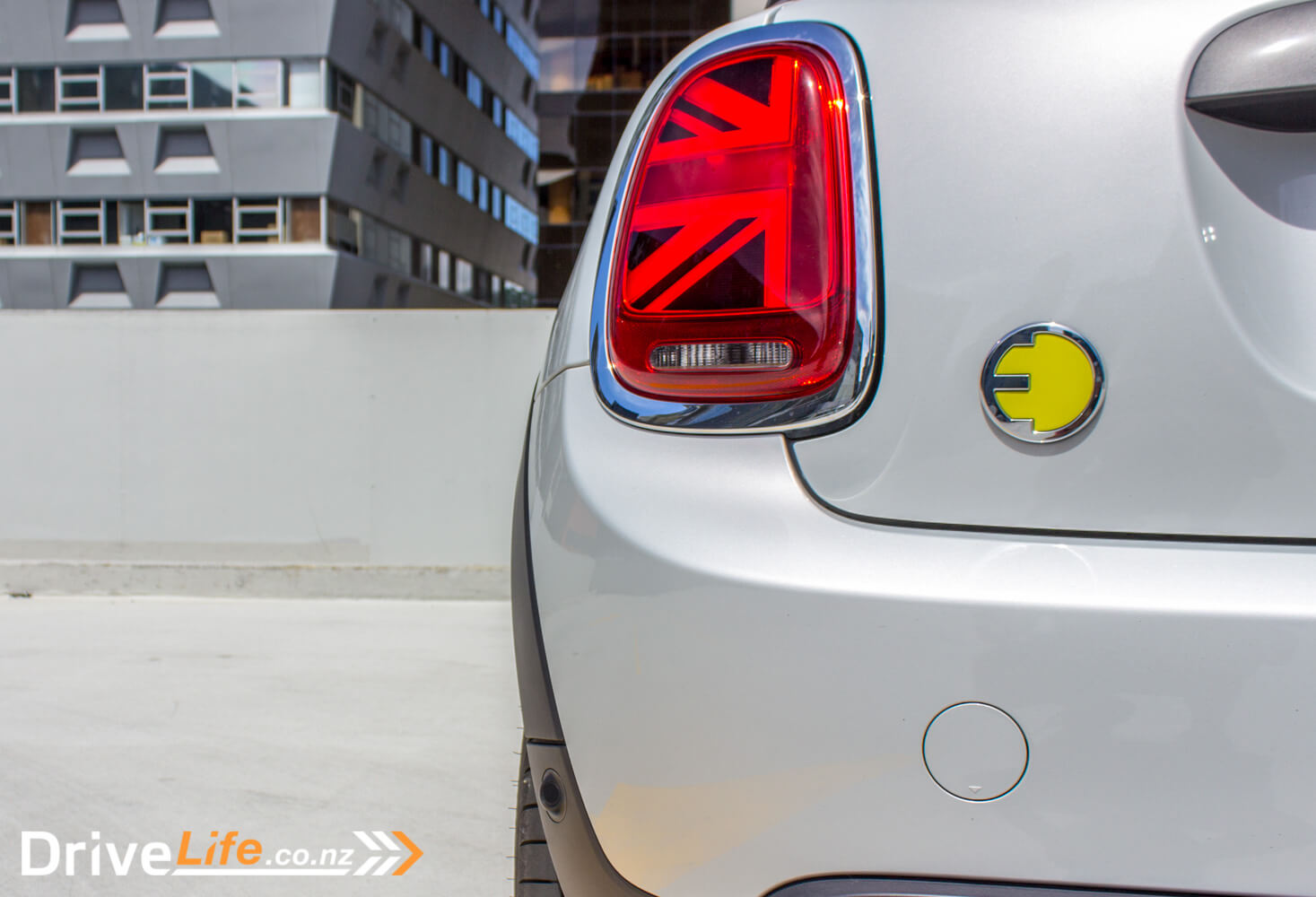
Speaking of the wheels, well they got a lot of attention. They’re certainly modern and different, and the yellow used lines up with the yellow used on the mirrors. Definitely a personal taste item and judging by the response I got on them, not a popular one. Thankfully, these can be changed at no cost to something more normal with Chilli Red or British Racing Green exterior paint.

MINI has kept the fake bonnet vent which helps the car retain some sort of good looks. I would have been happy for them not to cover the grille at all, but that’s just me.
Overall, it’s still a good-looking car, as long as MINI doesn’t change it too much in the future and make it look strange.

What’s The Interior Like On A 2020 MINI Cooper SE Electric Hatch?
The yellow accents are carried over to the interior with a splash of it on some fake carbon fibre on the dash, and also on the gear shift lever. Those new to MINI will be blown away by the interior at first glance; it looks very sporty, with those row of toggle switches above the centre console, and more toggle switches up on the roof. Sure, they’re old school but they still look good, and being actual alloy, they feel great. Up front, there’s a single 12-volt socket, and both a USB C and standard USB port.
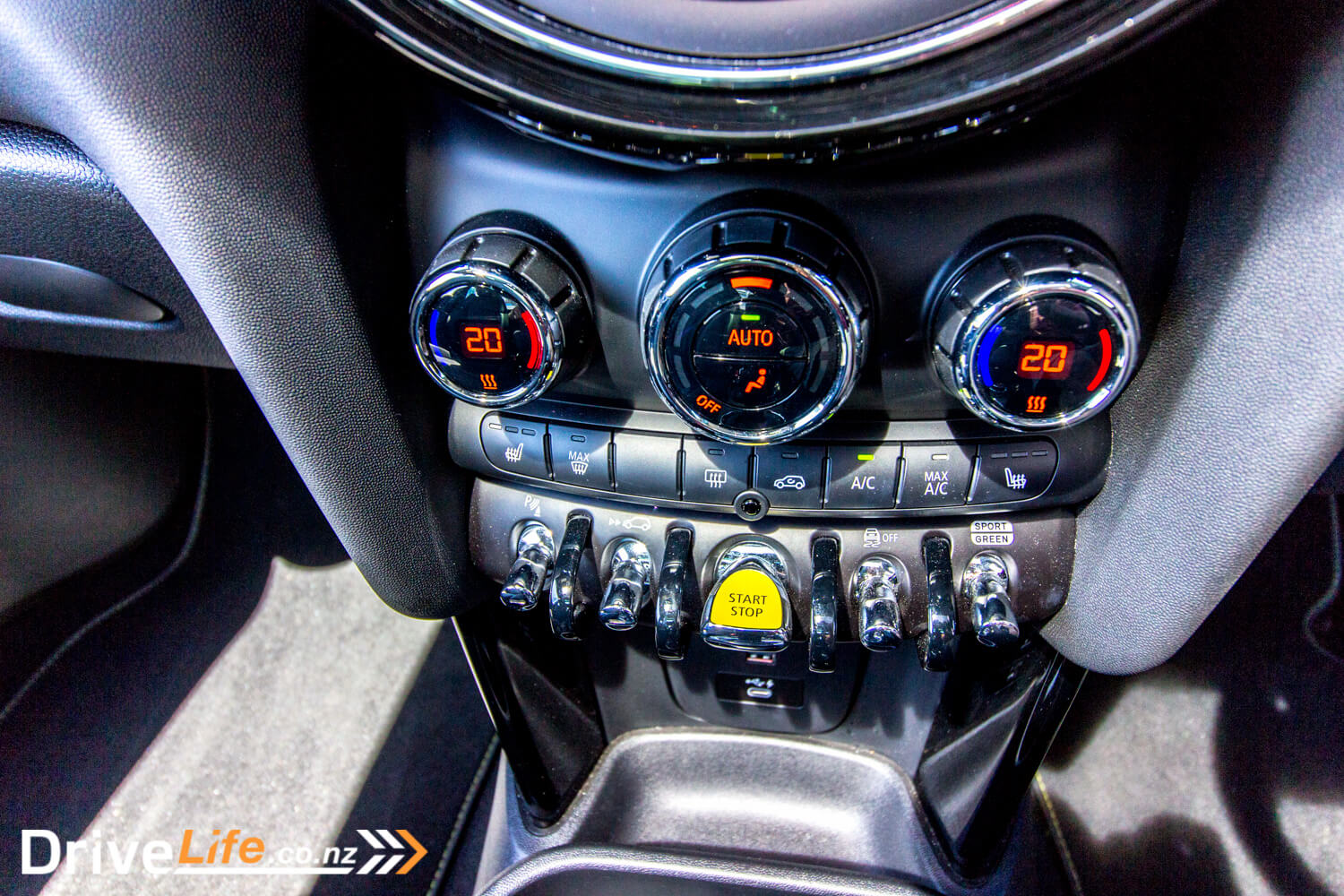
The dashboard has changed in the electric version of this car, it’s still a pod mounted above the steering wheel, but it’s gone flat-faced. You would think this would show reflections badly, but the face of the 5.5” dash has a matte finish, and reflections didn’t really bother me. The instruments are really clear too, with nice, crisp readouts. There’s very little customisation though, as in none.
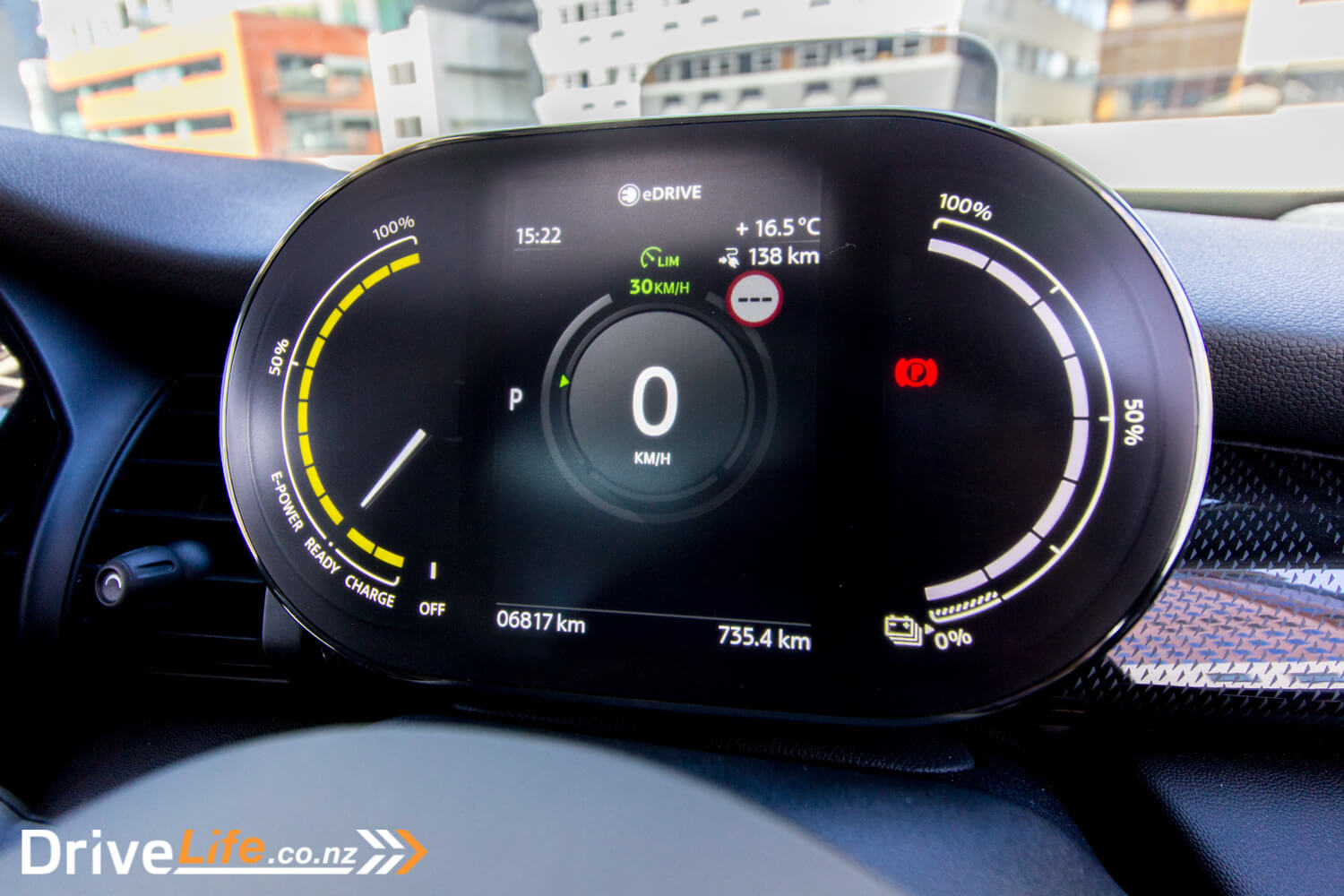
There’s no cubby in the centre console of this car, instead there’s a lift-up panel and under that you place your phone for wireless charging – assuming your phone can wirelessly charge. Only one gripe here; the width of the charger is quite restrictive, and I had to take my phone out of its case to be able to charge my phone. So it’s a tight squeeze, but still handy. Closing the lid on the charger also takes away the temptation to look at the screen.
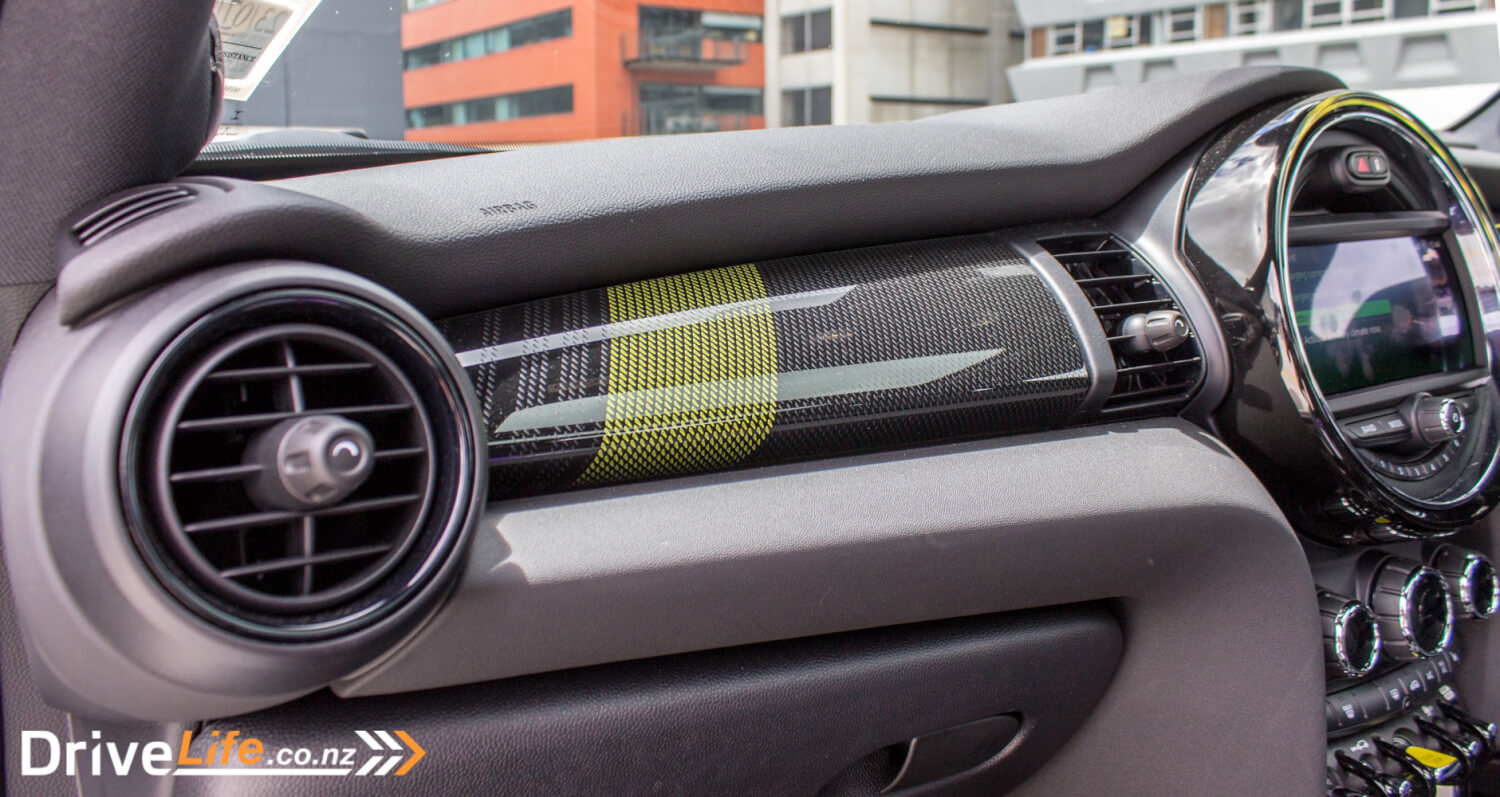
In the centre-front of the car is an 8.8” central display, which is controlled by a dial between the front seats. Anyone who’s driven a recent BMW will find this very familiar.
While all the seating is black, there is some two-tone grey used on the doors, and this helps break up the darkness a little. It’s a bit strange in the MINI Electric; at times it feels spacious and wide, and other times tight and a little claustrophobic, with all the blackness.
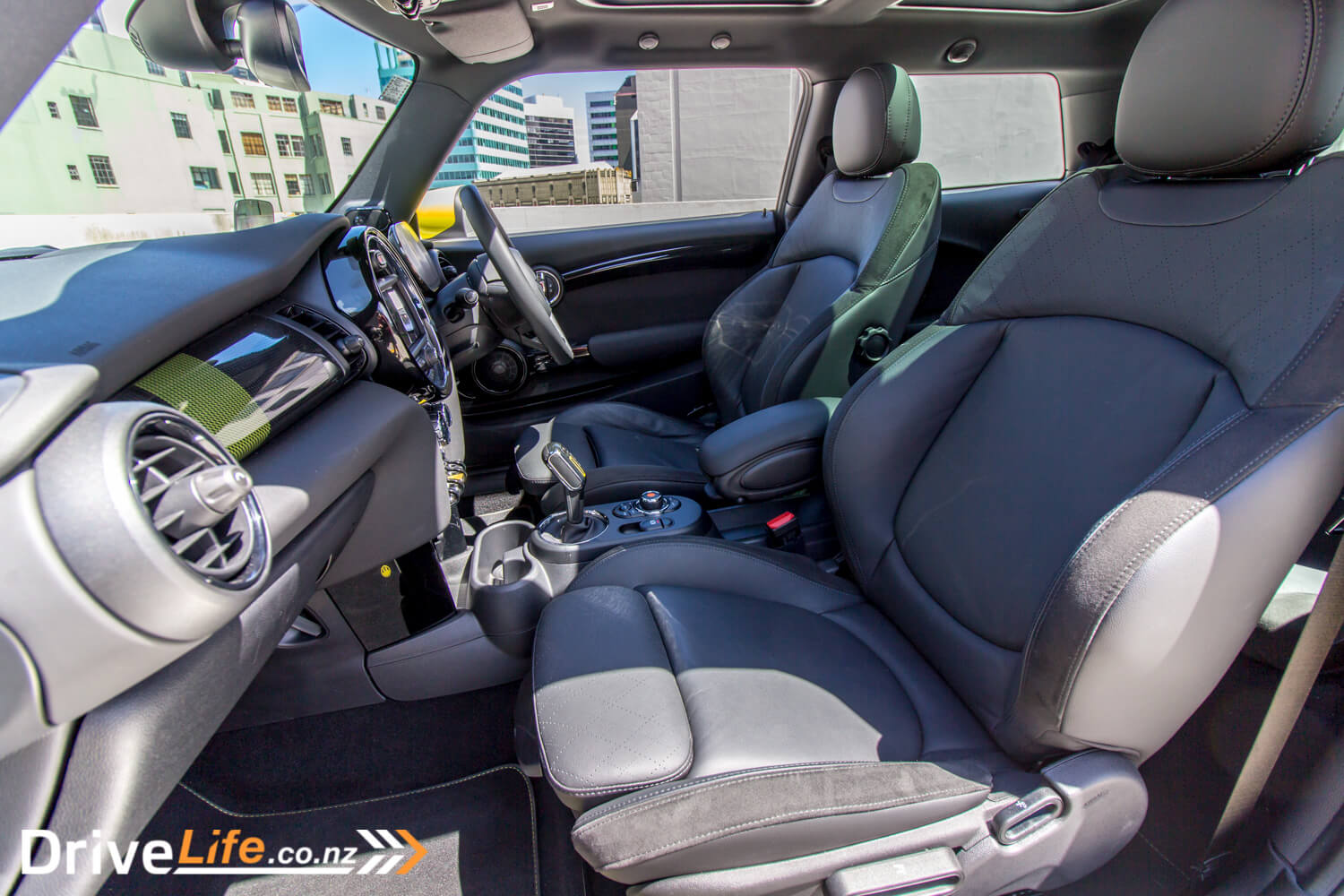
The seats are heated in front, and there’s no power adjustment. For you taller people, there is manual cushion-length adjustment, and manual lumbar adjustment.
The rear of the front seats are fairly heavily scalloped to give some extra legroom for your rear passengers, and the rear seats dip down a lot for extra headroom. I doubt it’d be a fun time back there on a trip to Auckland, but for short trips they seemed to do just fine for my passengers.

The boot has a false floor to it, always handy for storing extra junk in. In the lower part lives the electric charge cable, a tyre pump (no spare here) and some MINI gloves. It’s quite a large area under there, and you can remove the false panel to give yourself a bit of extra height for tall stuff. I’ll be honest here and say while I was taking photos, it took me over a minute to get that false floor out. It’s a bit of a Rubik’s cube to get it back in, too. Still, boot space is reasonable at 211 litres (3 litres bigger than a Corolla hatch), and it goes to 731 litres with the rear seats folded down.
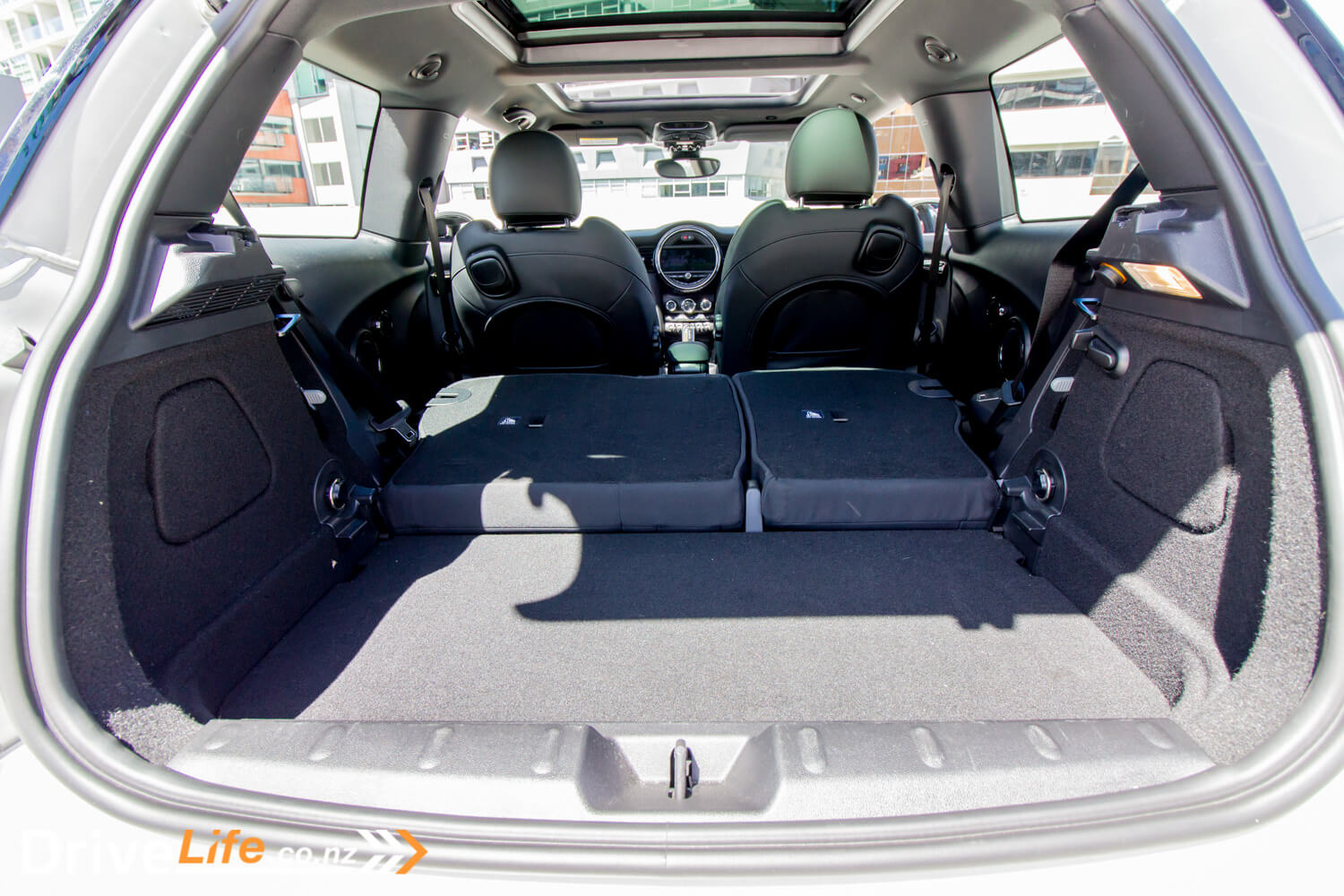
What Does The 2020 MINI Cooper SE Electric Hatch Drive Like?
As always with an electric car, the instant push of acceleration when you take off is enjoyable and addictive. The MINI Electric is no exception, and at 7.3 seconds to 100km/h, it’s no slouch, and will see off many petrol-powered cars at the lights.
And that was running the car in ‘Mid’ (normal) mode. Stick it into Sport mode, and you feel the car tense up, as it just wants to go now. This is a fun part of the car, make no doubt. It looks sporty, and it accelerates very well. Wheelspin in the dry is easily possible, so you’ll need to watch that right foot, and in the wet, flooring it at 50km/h will see the front wheels spinning too.
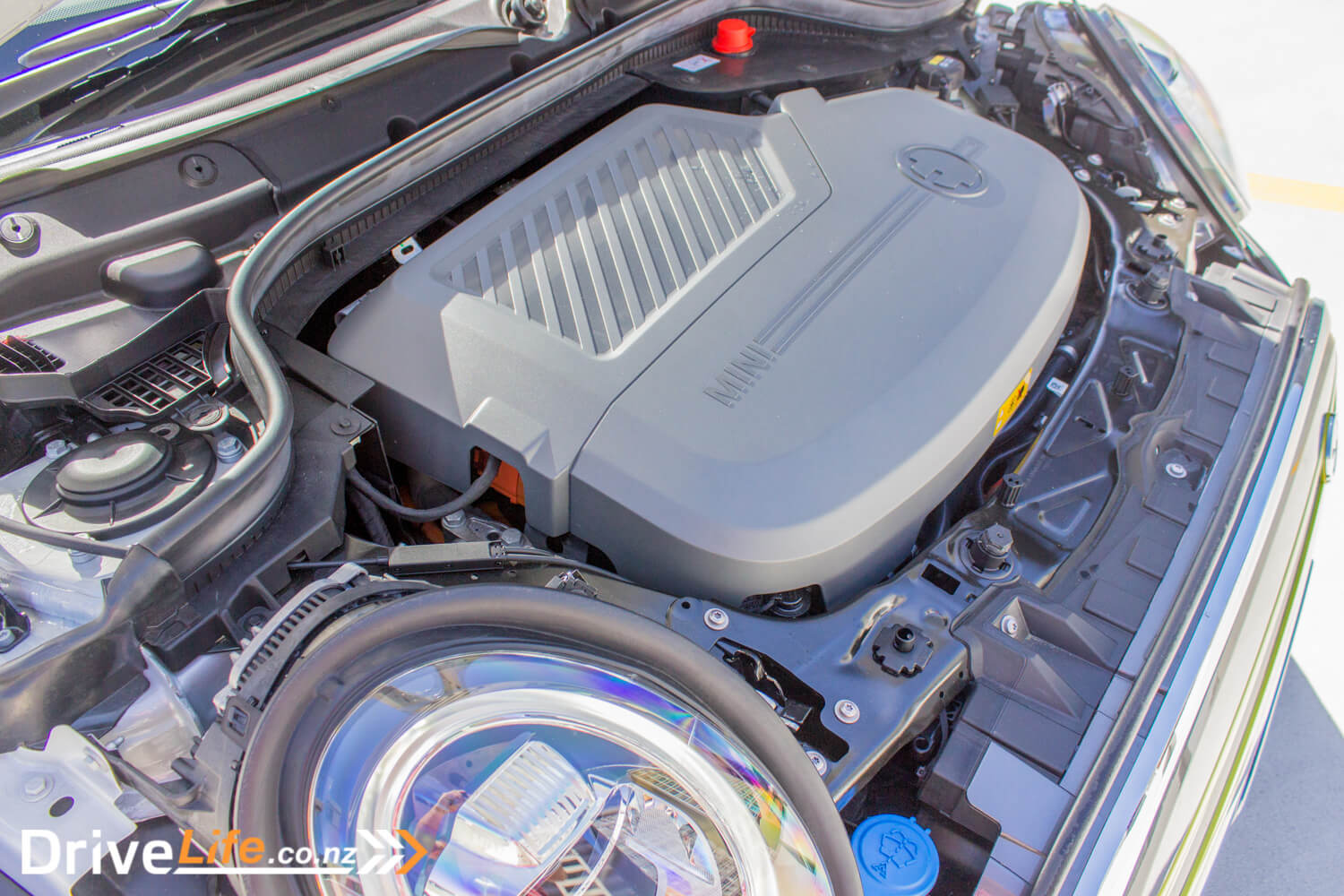
There’s also Green and Green+ drive modes to pick from, and with all that torque and relatively low weight, the car can easily cope with either of these modes. Switching on Green+ will kill the aircon and heated seats, so I see this more of a ‘get you home’ mode if you are low on range. Naturally, there’s also reduced performance to save battery power. A shame that none of the drive modes stick when you turn the car off; if you have it in (say) Green mode and then get out of the car, it will always reset to Mid mode.
Selecting Green or Green+ does mean you get to access the MINImalism feature of the infotainment system. This screen shows a fish – a green fish, and looking very Simpsons-ish – who will jump out of his bowl when you gain a star for Acceleration or Anticipation. The fish itself isn’t animated while it’s waiting, so it is just static until you get a star. Initially, I thought this would be great entertainment for the kids, but I think they’d get bored with it after a while. It’s a similar feature that encourages you to be lighter on the accelerator and anticipate changes in traffic, such as the growing trees display in a Nissan Leaf. Be warned, if you are aiming for 5 stars on either or both, flooring the accelerator will see all your stars for acceleration disappear instantly.
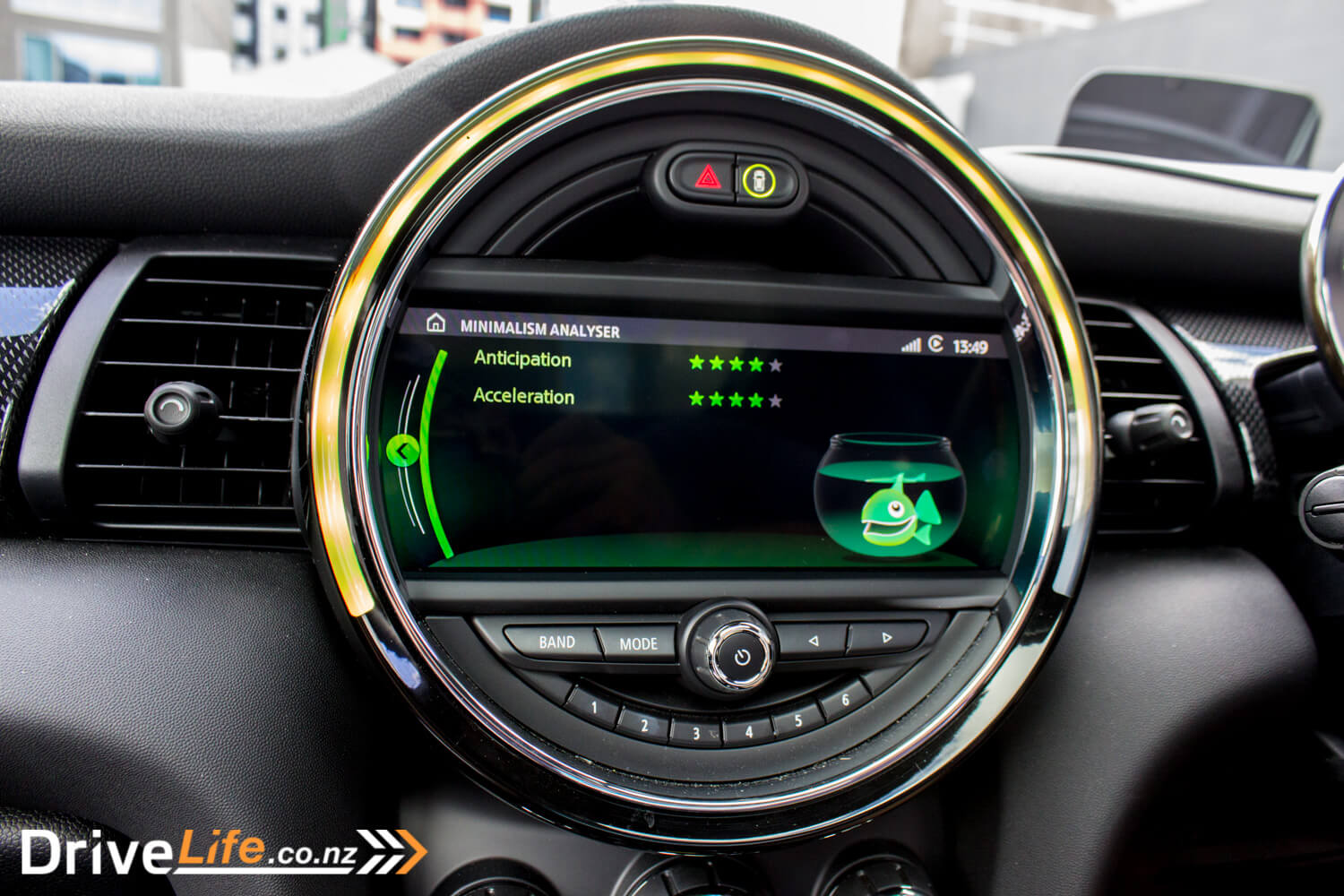
There’s two switchable brake regeneration modes in this car; Low Energy Recovery and High Energy Recovery. It’s easy to tell MINI really wants you to use the High mode, as when you select Low brake regen, an orange light inside the toggle switch comes on as a warning. Also, when you get out of the car and back in, it reverts to High brake regen. Not that there’s anything wrong with that, and that High mode is intense. It washes off speed very quickly, and honestly, you will rarely use the brake pedal. This is as close to one-pedal driving as a Tesla. I did switch brake regen to Low on the motorway, as you don’t want to freak people out by de-accelerating so quickly in motorway traffic. Of course, this does give you a nice little boost of battery charge, especially down a long hill.
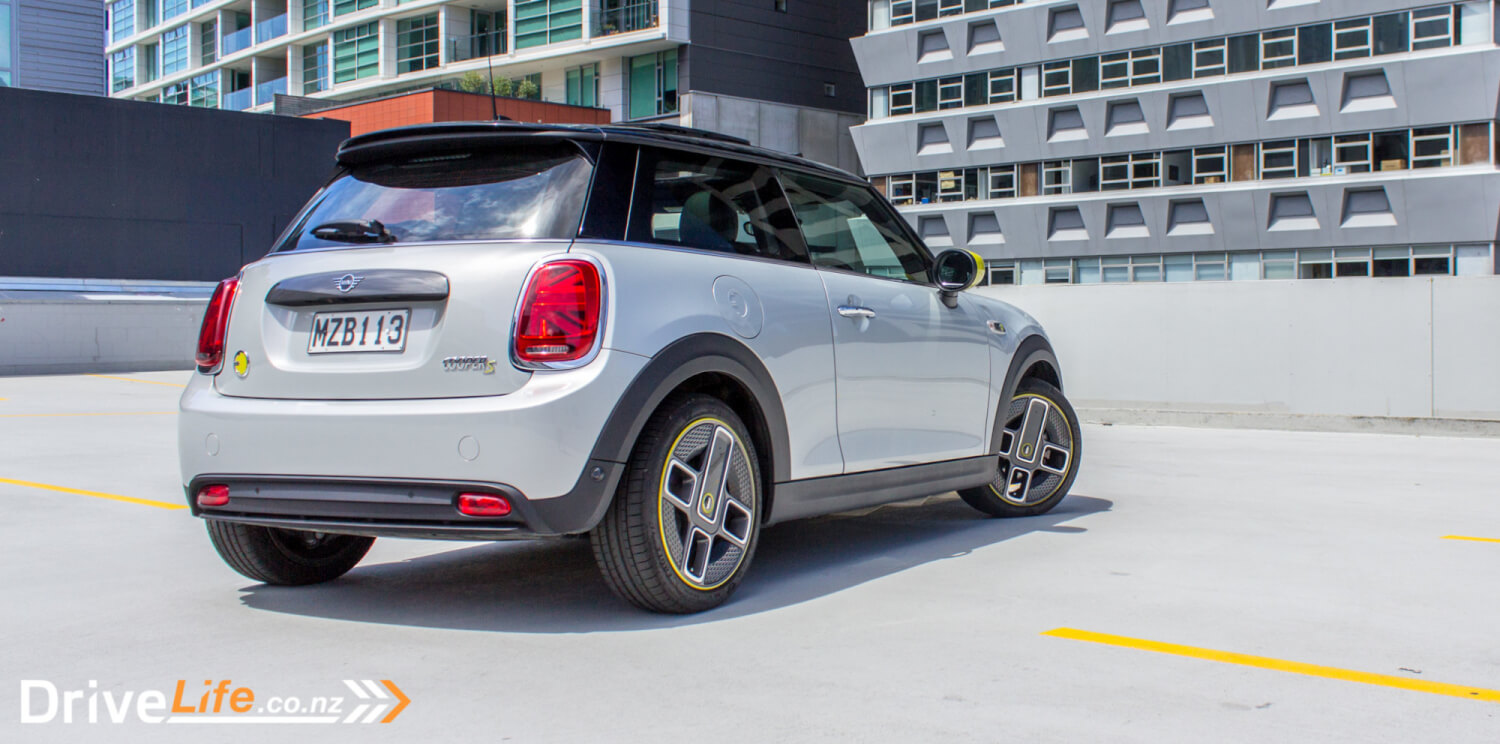
Brake regen in High mode will stop the car on the flat, and even downhill to a point. Weirdly then, I found when I went to take photos, the front wheels were covered in brake dust and had to be cleaned. I would have thought of all cars, they’d be completely clean.
I missed one ‘feature’ (?) of starting the MINI Electric. On hitting the Start toggle switch, you are met with sounds I can only relate to being a little like a light sabre. I’m not sure of the reasoning behind the sound, but it’s there and can’t be turned off. There’s a similar sound when you turn the car off, too. The car also has an electronic driving noise up to about 30km/h, and it’s there even when the car is stopped. I’d like to be able to turn this off, but apparently it’s a regulatory thing in the EU and can’t be disabled.
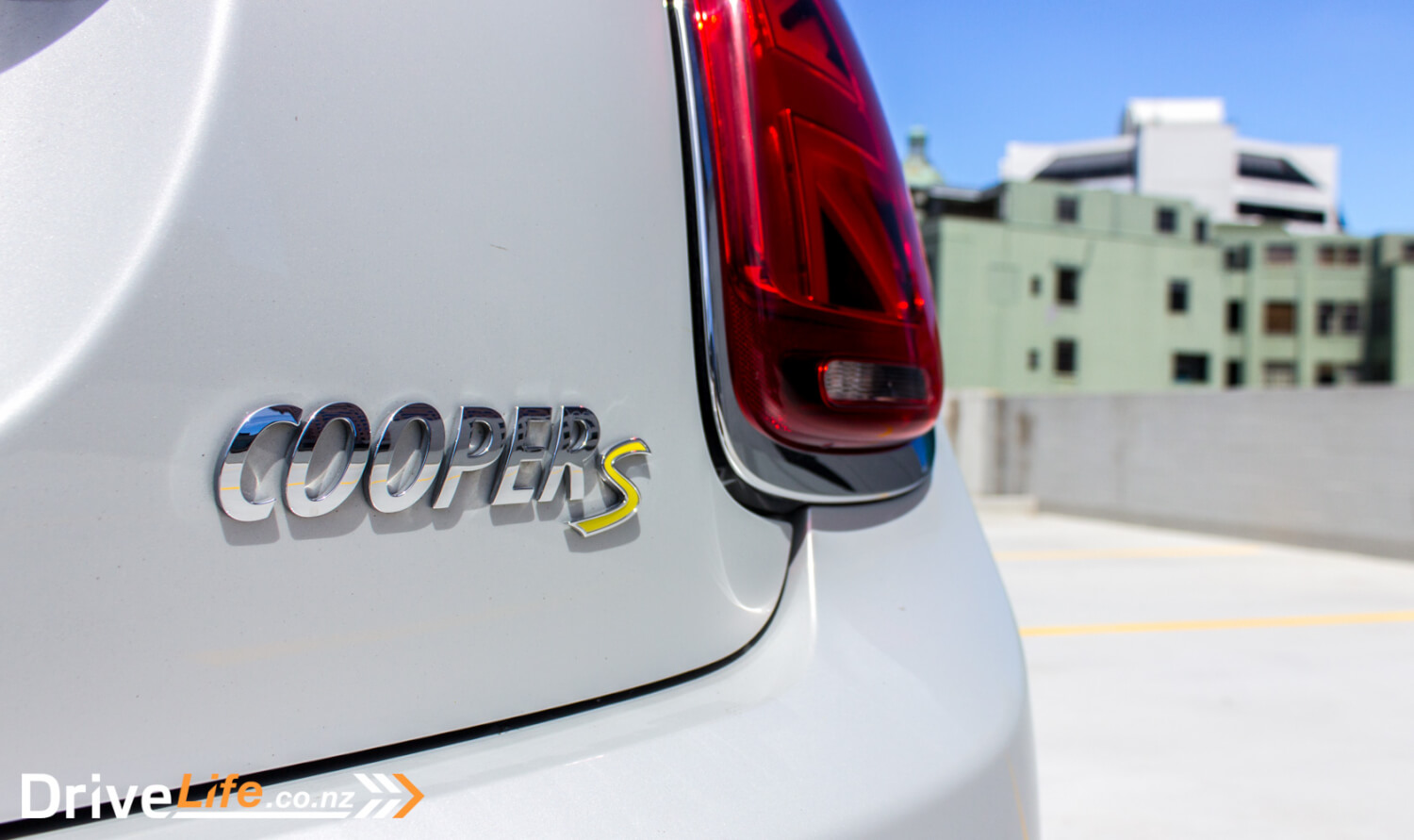
Getting into the car at night will see some cool MINI logos appear on the ground, always a great party trick. The central ring around the infotainment centre is quite cool too. Similar to other MINI models, you can change the ring to be a colour for different things. For the MINI Electric it might be the drive mode you are using (green for Green or Green+, orange for Mid, and red for Sport) or the battery state of charge. Admittedly I set it to drive mode, and then forgot about it. One handy feature of the ring though is if you get too close to another object, like a bollard or another car, the ring will instantly go red in warning. Nice to have a secondary way of knowing you are too close to something – the centre display also lights up with a car graphic showing you where you are close to another object.
Still on that central infotainment system, the MINI Connected app is standard. This has functions such as pre-conditioning interior temperatures before driving, displaying battery charge status, and generating stats. It also can be used to display news, weather, and Wiki Local. And yes, this is the same system as a BMW has.

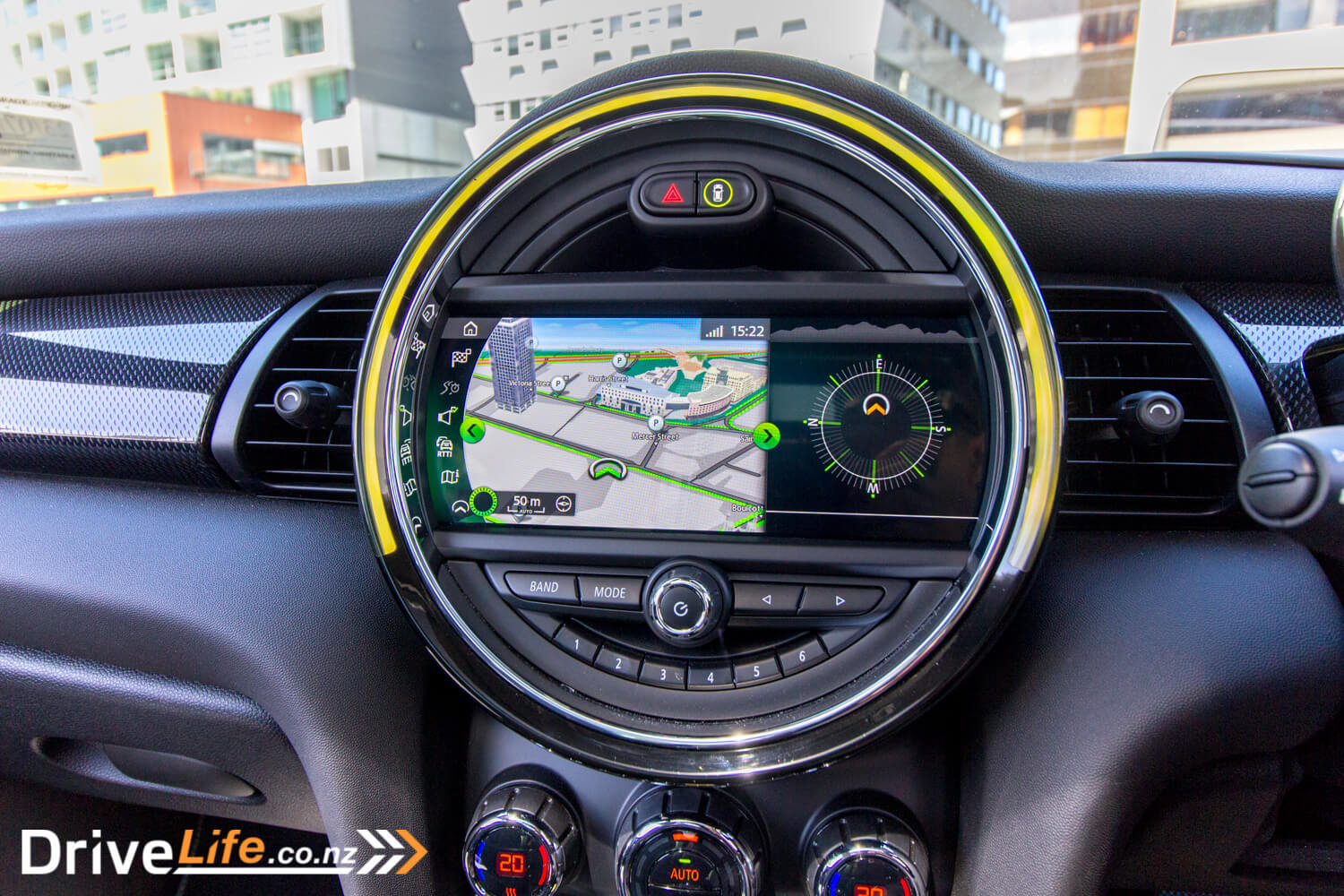
While the MINI Electric is primarily aimed at city users, there’s still times when those people want to go on the motorway. It was for this reason I was really surprised that the car only has standard cruise control, and not adaptive cruise. Adaptive cruise is a major safety feature in stop-start traffic on the motorway or just in general, and I would have thought at $60K, it’d be standard. The car does come with adaptive LED headlamps, which are always nice. But if the car is aimed at city buyers, this seems like overkill. I’d rather have adaptive cruise, thanks. At least the standard cruise control the car has is a one-touch on system, something that’s appreciated.
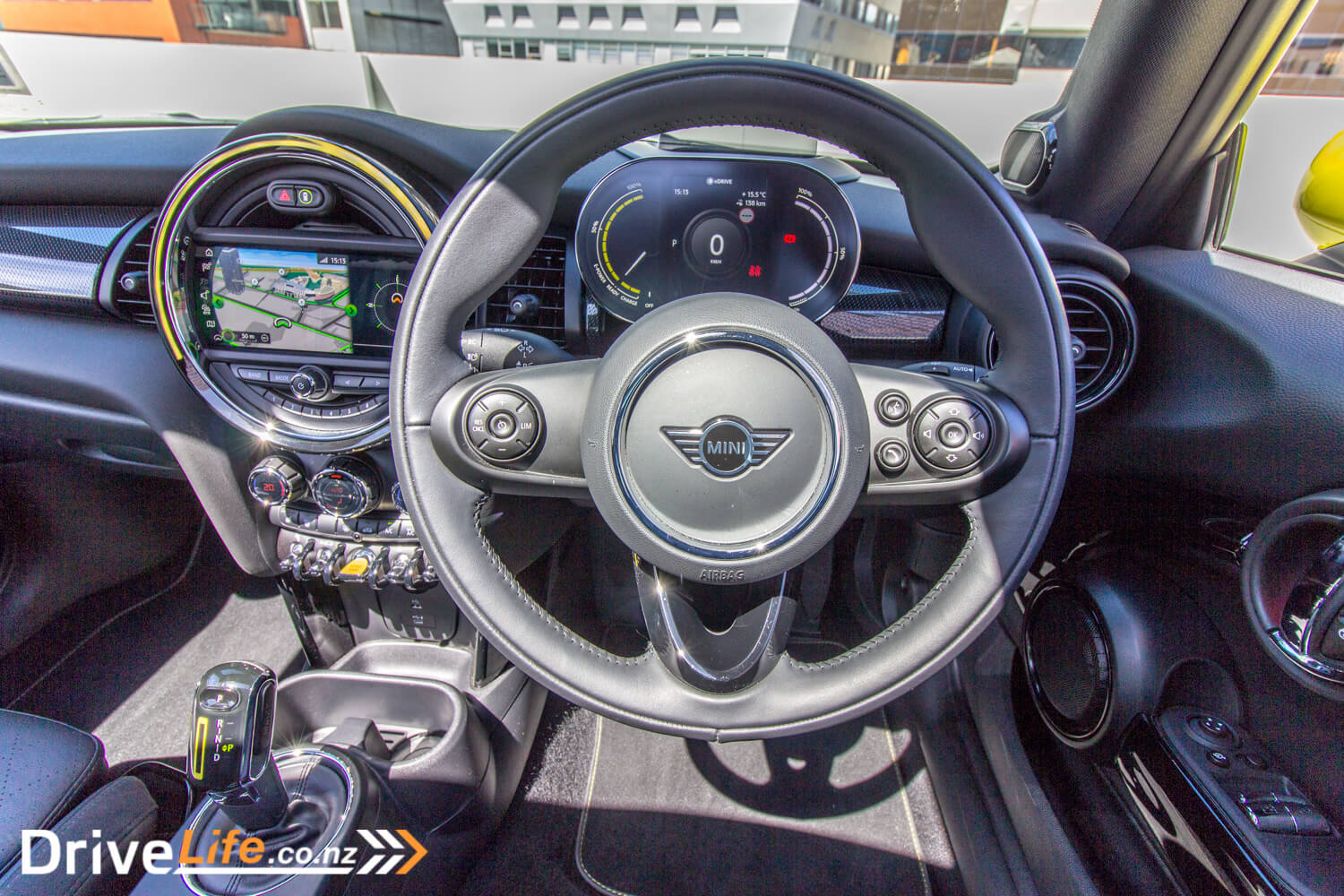
Blind spot monitoring is also missing, but thankfully with those big, long doors, visibility out of the car is reasonable, barring that chunky C pillar. There is one drawback with the long, frameless doors; They look awesome when open, but when driving the sun visors in this car are very short, and once folded out to the side barely covers 40% of the side window. This means if there’s sun coming in the rear of your window, there’s no way you’re going to be able to block it out. At a minimum, the car needs sliding sun visors so you can move them along. Sunstrike was an issue for me due to this.
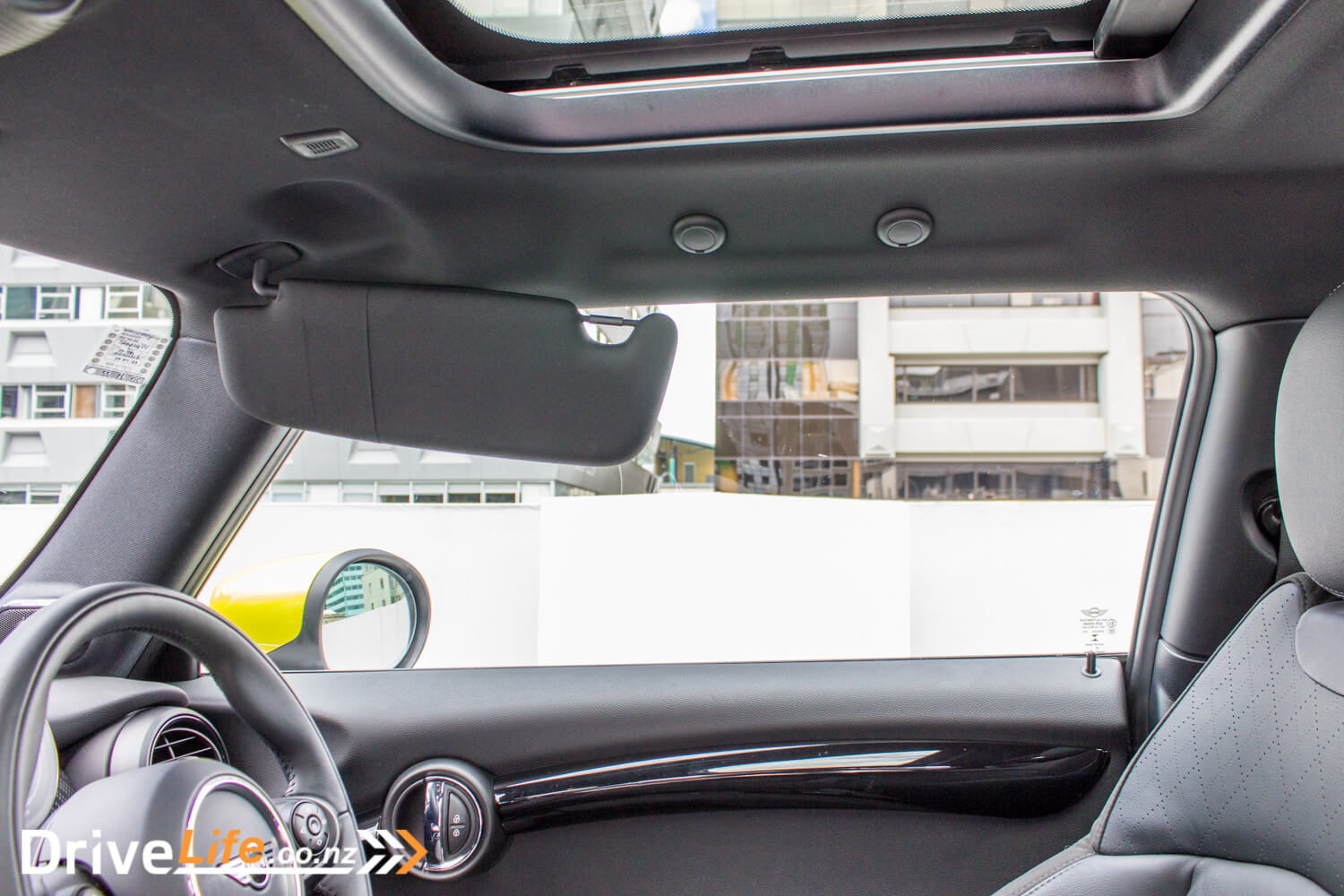
Brake auto hold is another item that’s MIA. There’s an electric park brake, but for some reason MINI chose not to add brake auto-hold to the car. For a car that’s designed for city use, this is a big item that’s missing.
I’m going to cover off one last thing I didn’t like, then we can stick to the good stuff. To start with, the ride in our test car was pretty bloody hard. This may be down to Wellington’s streets, but the MINI Electric was not a fan of bumps. According to MINI, it has go-kart like handling, and while the ride quality is better than a go-kart, it’s still very firm. In saying that, our test car arrived with about 6,000Ks on the clock, and by the time it hit 7,000Ks with me, the ride had improved to the point where it was acceptable. It’s still very firm, but you can live with it. Hopefully it just needed that extra mileage on it to soften it up some. We’ve seen this before with other cars, but it doesn’t normally happen in that short an increase in mileage.
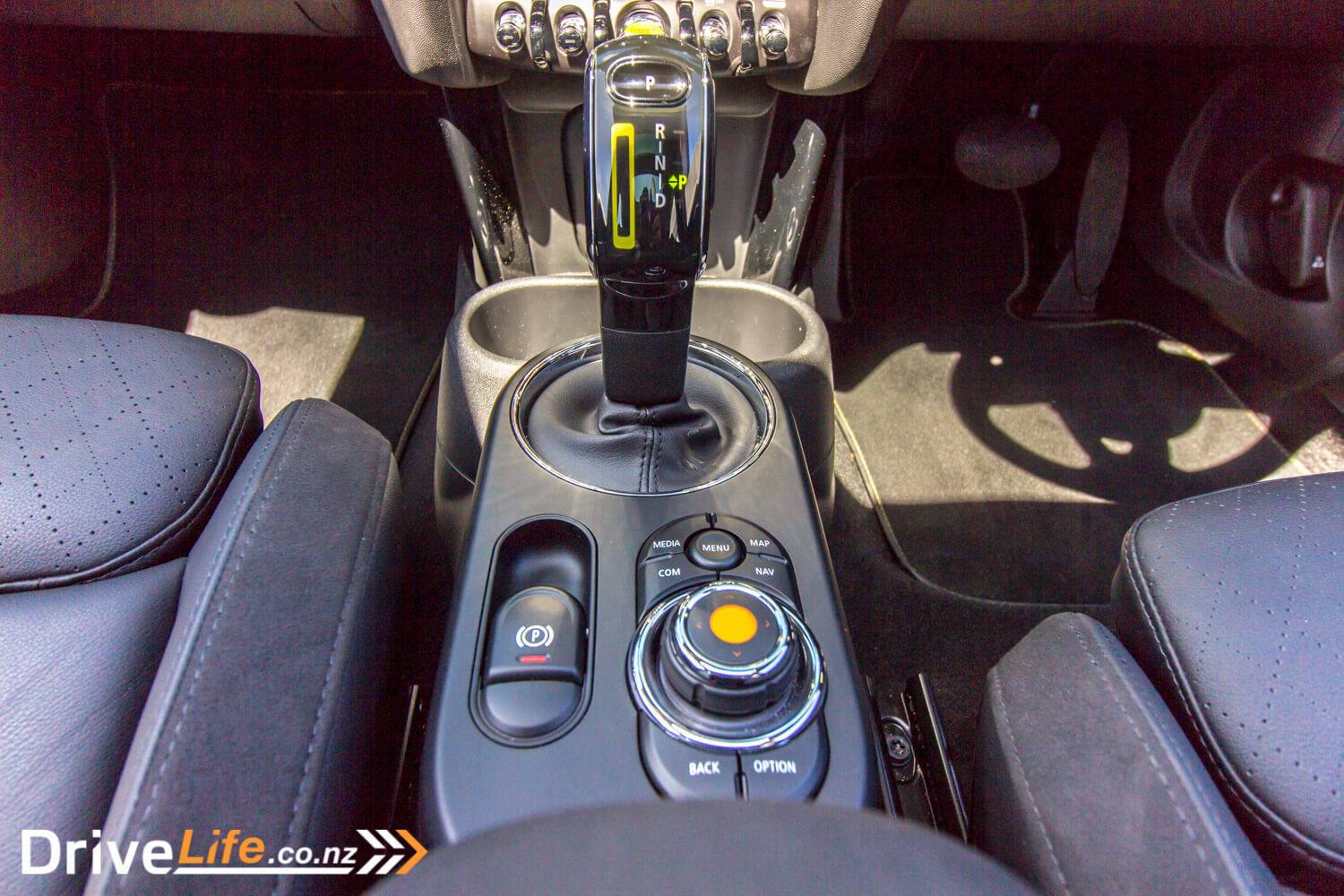
The MINI Electric has a heads-up display (HUD), but it is the cheaper version, with a small piece of plastic that pops out of the dash when you turn the car on. Still, it does the job, and shows you your current speed, the speed limit, any SatNav directions (including a countdown to your down meter) and other info. While a ‘normal’ HUD is better, this is better than nothing.
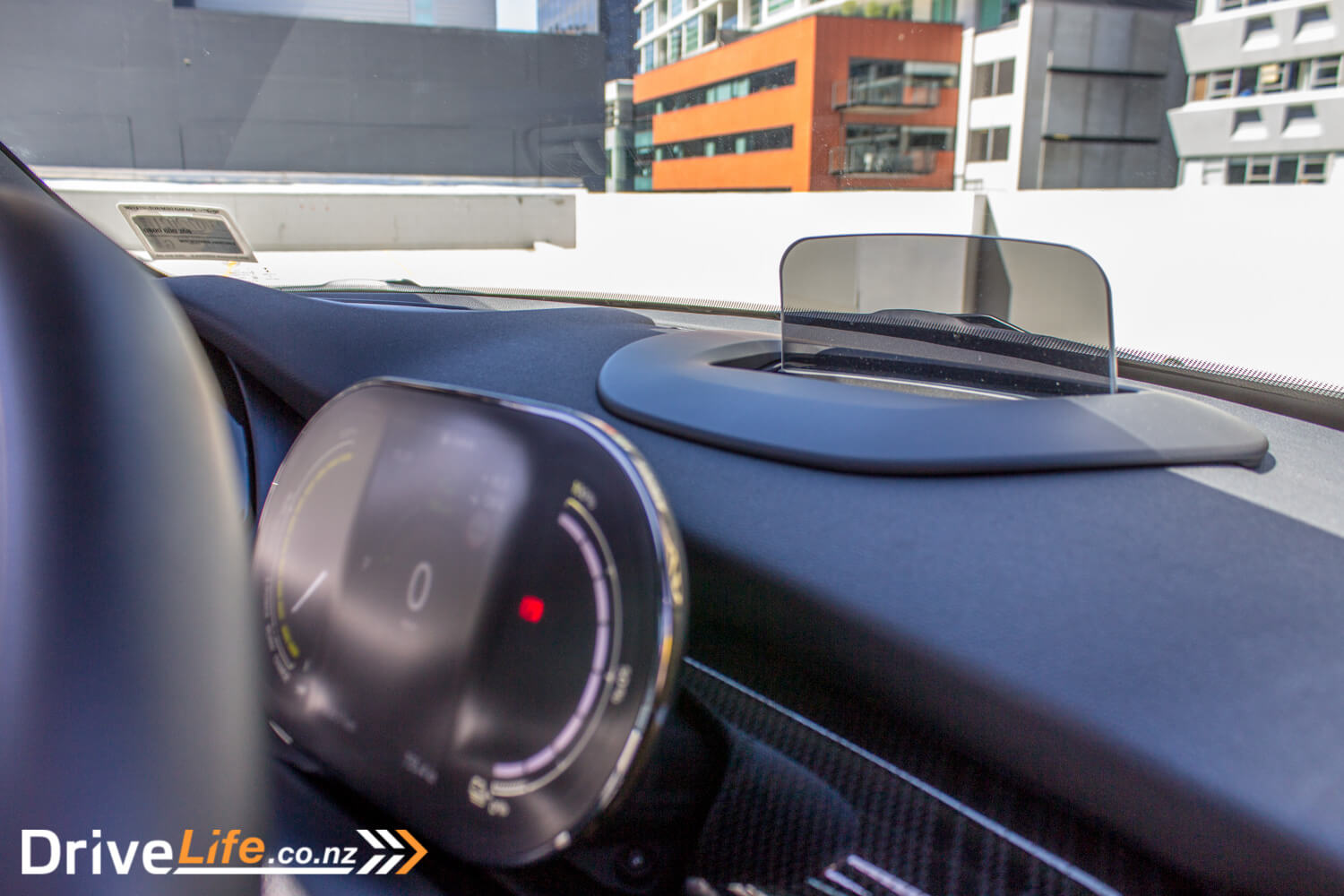
Sound quality is top notch, with the standard Harmon Kardon sound system. The tweeters are perfectly placed at the bottom of the A pillar, and there’s some awesome separation and a good range of frequency. No complaints here at all.
Other good stuff? The turning circle is excellent, managing tight turns in city streets with ease. As mentioned, there’s Apple CarPlay and Android Auto, and very happily, Apple CarPlay will work through Bluetooth, and you don’t have to pay a $500 premium to get this (as you do in a BMW). In all laziness all this means is that you don’t have to plug your iPhone into a USB cable to use Apple CarPlay, but for me it’s one less thing to do; just get in and drive.
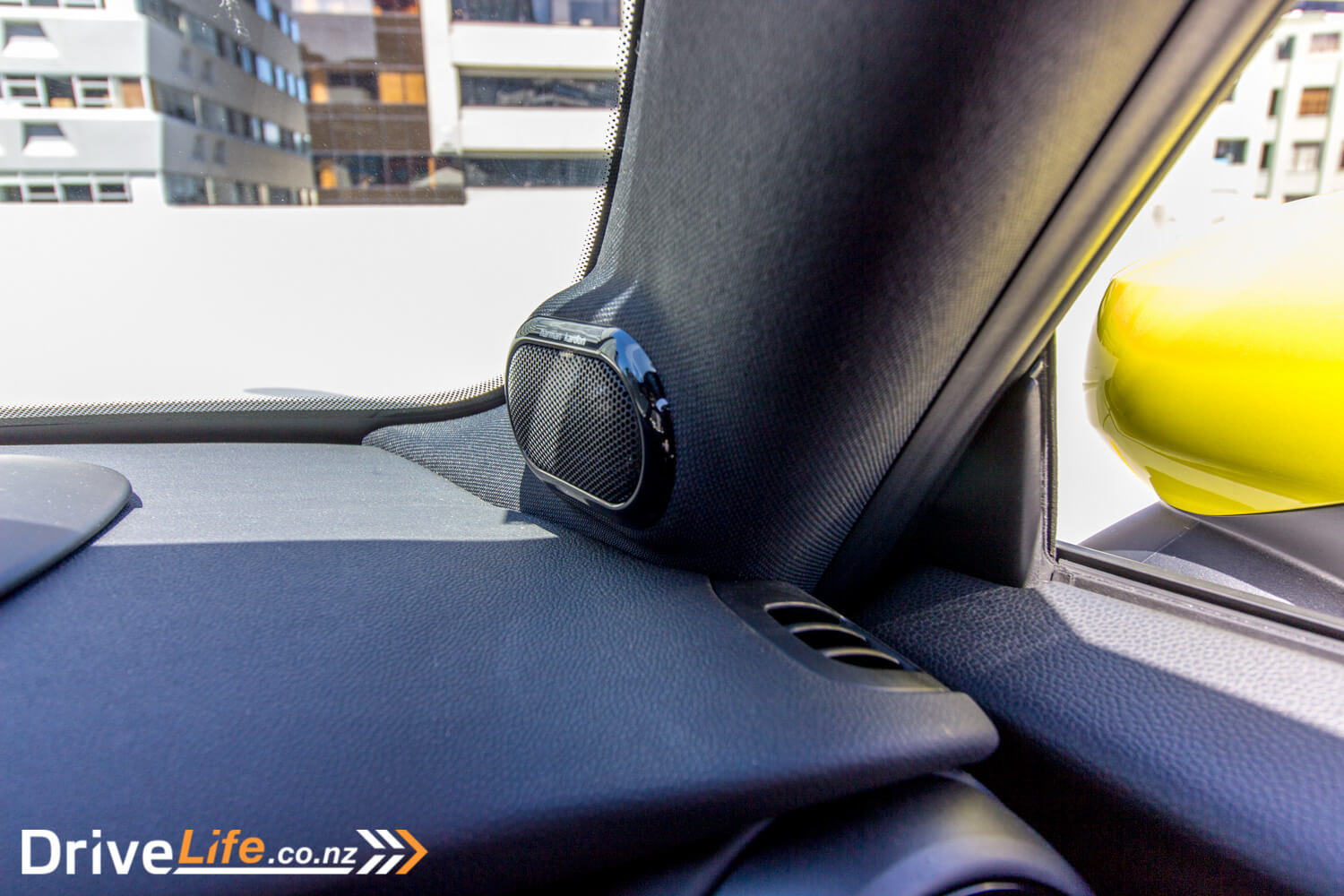
The central screen quality is excellent, with decent resolution. Ditto the reversing camera; nicely clear. The screen itself, while 8.8” wide, is definitely a landscape unit – quite narrow due to the housing around it. I’d been keen sometime to see MINI make the whole central unit a screen.
Handling-wise, MINI says this car is still designed to handle like a go-kart. Deciding to take up the challenge, I took the car out to a particular road with lots of twisty corners, not quite go-kart territory but a road that can really show a car’s handling. The MINI did excellently, far better than I thought it would. Turn in was excellent, steering very good, and it tracked the corners fantastically. I had brake regen on the max setting of course, and this meant I didn’t need to use the brake pedal, saving time. If I was going too fast, I came off the ‘gas’ pedal, let brake regen do its thing, then back on the accelerator out of the corner. I could modulate my speed using this method too – if I didn’t need braking, I just took my foot off the accelerator enough to keep the speed up without braking.
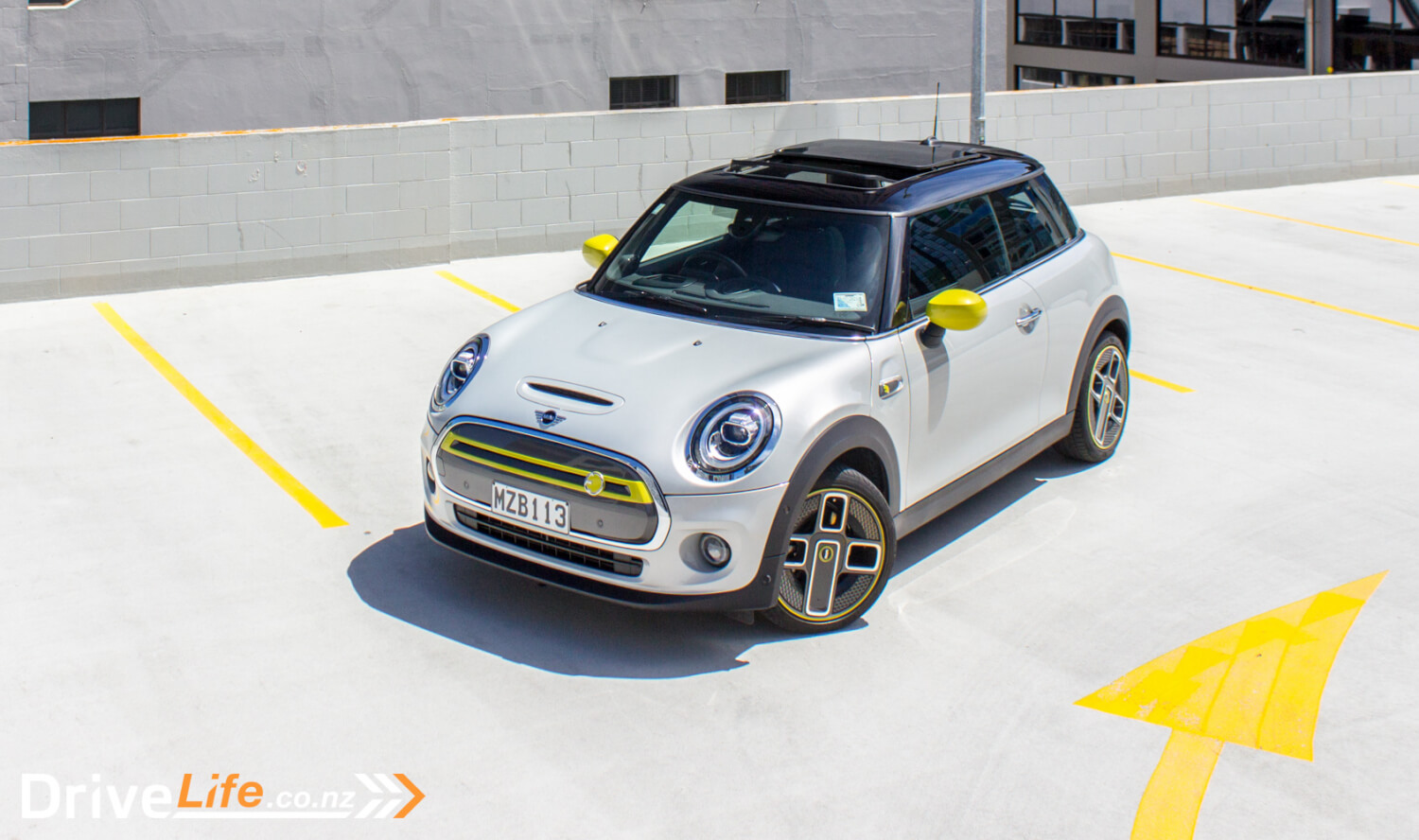
It was all too easy, and a blast of a drive. Naturally, acceleration out of the corners was stunning, and the grip was great too. I’m happy to say that instead of fitting some extremely hard compound tyres for economy, the MINI Electric has Goodyear Eagle F1s. They gripped until the last, and were perfectly matched to the car.
If I’m being honest, the back of the car did step out a few times when hitting a bump mid-corner, but there was no drama along with it. Once over the bump the car settled back down and got on with it. It almost felt like I should have been in The Italian Job. This car is FUN!
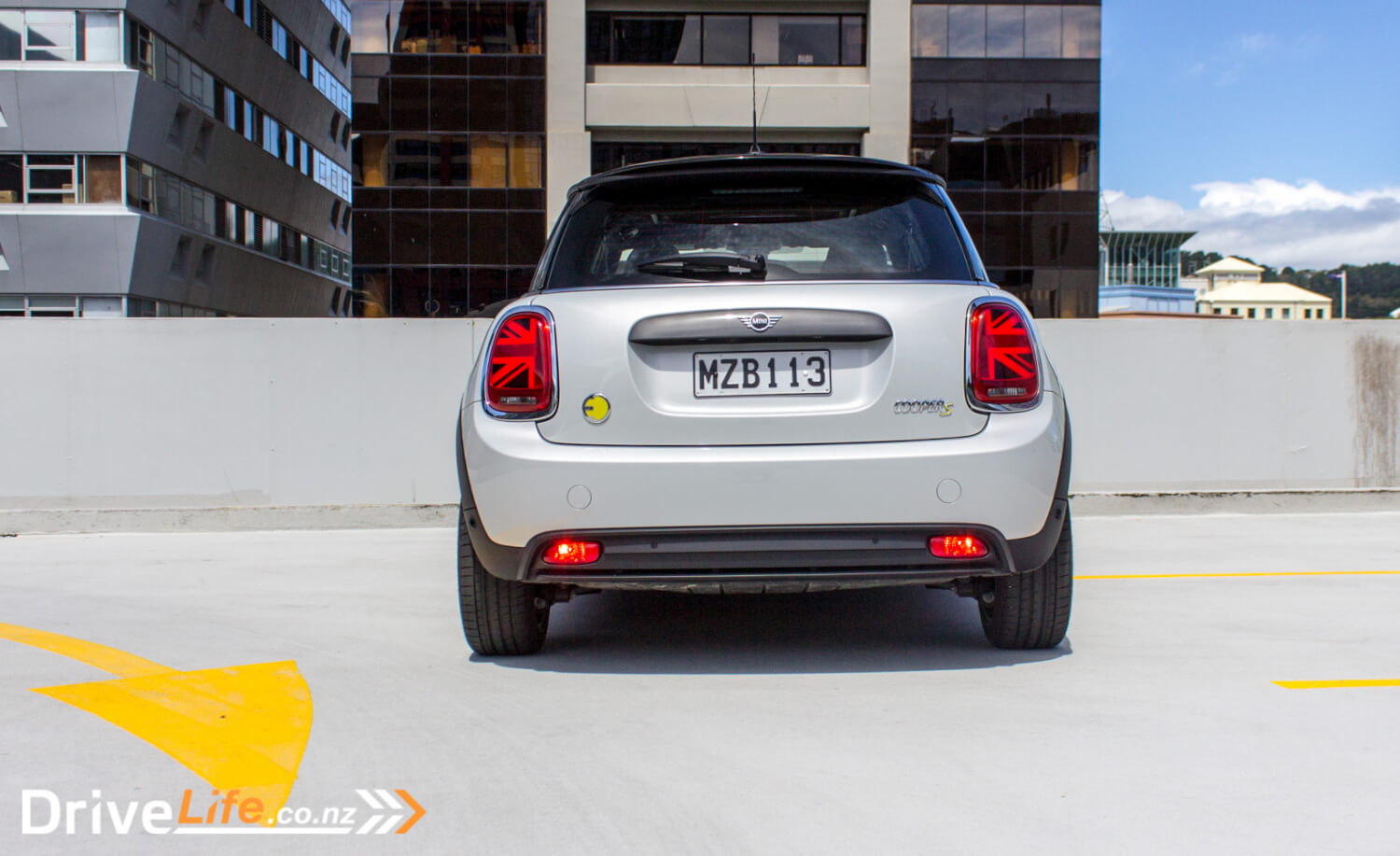
One drawback of the Eagle F1 tyres is tyre noise on coarse chip seal. Coarse chip seal brings out some noise that you eventually get used to, but is not pleasant at times.
Well, what about charging, and range, and all that stuff? We know charging isn’t an issue; plug it in at home at night. That’s pretty much it. When people ask how long it takes to charge up, I say it’s less than a minute – that’s how long it takes to plug it in. So easy.
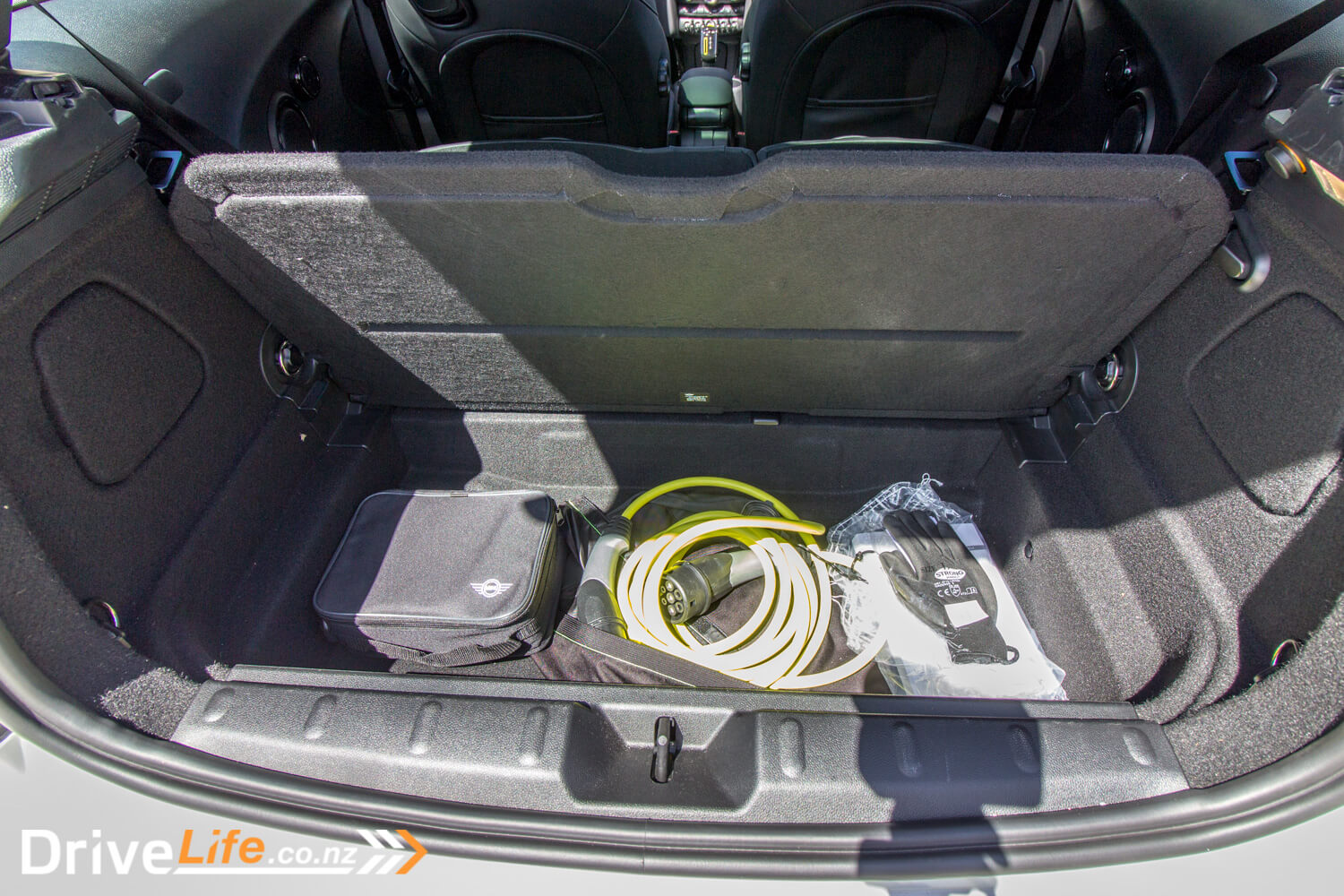
But our test car didn’t initially come with the ‘EVSE’, or home charging unit, so I had to rely on fast charging for the first week or so. Leaving home on a 45Km commute, including motorway traffic, got me worried. Then, I got to my destination to find I’d used 14Km of range. This seemed too good to be true, and I didn’t repeat that again, but it felt good at the time.
One day I was heading back to the city, and the batteries got to 8% remaining. I called into a ChargeNet fast charger and plugged in. Went and got a haircut, came back and it was done to 95% full. That took 46 minutes (luckily there was a queue at the barber shop anyway) and cost $18.26, for 26.4kWh of charge. Keep in mind, normally you’d only charge to 80% at a fast charger, but since I didn’t have the home charger at that time, I pushed it up to 95%. That 95% gave me 179Km of range. I have to say, I never saw 200Km range on a full charge, ever, and the max I saw was 197Km. I know the WLTP range is 233Km, but I also know that Wellington is one of the hardest places on EVs, ever. Our hills fair suck out range like nothing else. We see this same result with other EVs we’ve tested, so the MINI Electric is not alone.

Another weekend, we shot over to Masterton for lunch. We left home with 161Km of range, with a 115Km drive according to SatNav directions. We got to Masterton with 79Km and 50% battery left. Considering that meant going over the Remutaka Hill, using 82Km of range to drive 115Km or so is more than reasonable. I plugged the car in while we had lunch, it took 28 minutes to get it to 95%, taking 15.6kWh and costing $10.95. I was still eating lunch when the car had finished charging.
When you think about it, $10.95 to go 115Km is not really cheap. With the petrol-powered Cooper S using 5.2L/100Km, that equates to around the same price in petrol as it cost in power. But remember that was me using a commercial fast charger. Charging at home should always be your first choice, when you can. Once I had the EVSE, I just plugged it in at night, if I needed to.
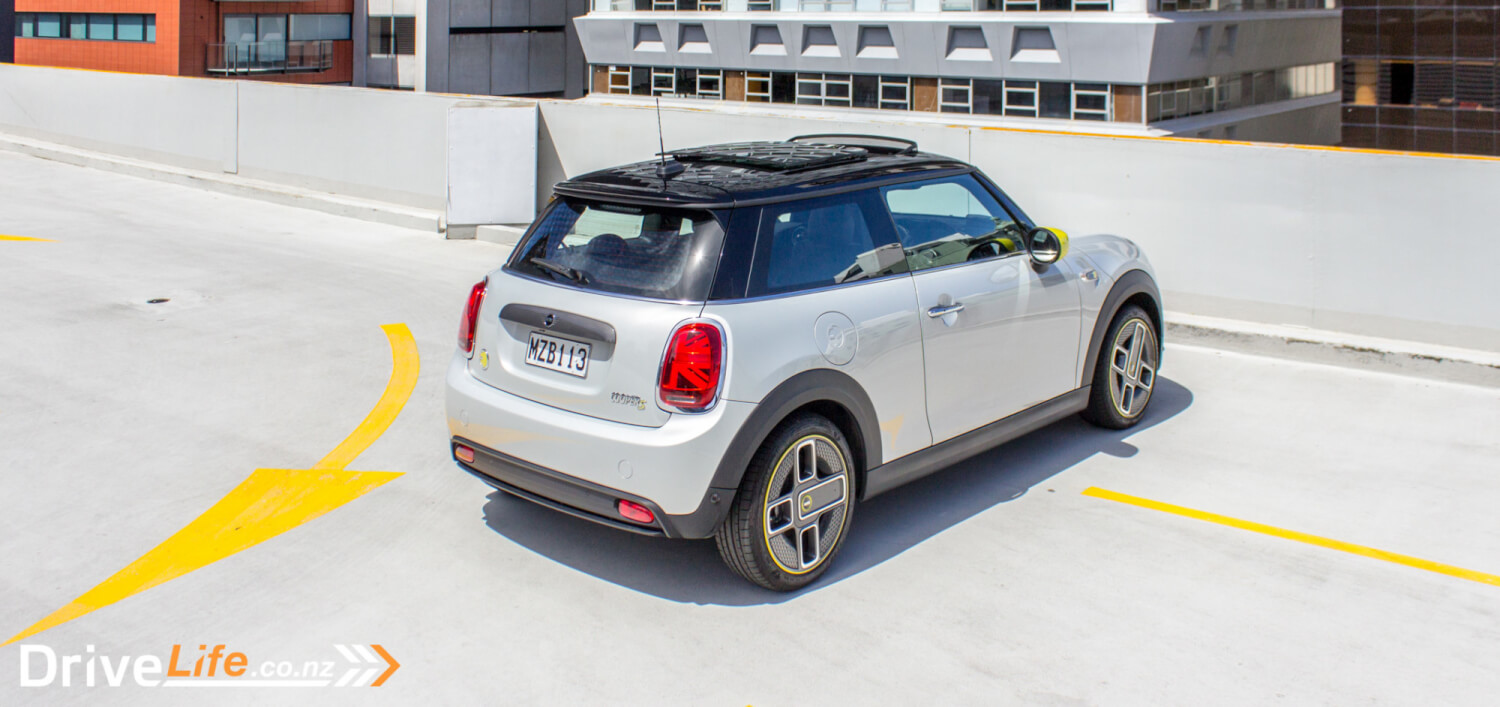
I’ve got to say that I’m not sure if it’s the MINI Electric or simply my perception has changed with more EVs that we’ve tested, but I didn’t care as much about the range as I used to. For example, some days I’d be down to 20Km range left. A few years ago, I’d be freaking out, but now? It’s a ‘meh’ moment, as I know 20Km is going to get me around town and home easily, so why worry? This was highlighted again and again during our 3-week test. Driving EVs is all about attitude and driving style, and the more you drive an EV the easier it is.
According to MINI, the car should use 15.2 kilo-Watt-hours (kWh) of battery per 100Km of driving. During our 3 weeks and around 1,500km, we averaged 13.8kWh/100Km. For a change, this is better than what MINI and the WLTP says, and is better than the 15.4 that we got out of the Hyundai Kona EV but a little more than the 12.7 we got out of the e-Golf.

What’s The Competition For The 2020 MINI Cooper SE Electric Hatch?
Really, it’s all down to your requirements. For not that much more money, you can get into a Tesla Model 3. More space, more pace. But since the MINI Electric is aimed at city dwellers, would they consider the much bigger Model 3? Likely not.
But knocking on it’s door is the tried and true Nissan Leaf; more range, more seats, more a known model. Still it’s the same story as the Model 3 – it’s unlikely a MINI Electric owner would consider a Leaf.
Good to see we are getting more options down the ‘cheaper’ end of the EV market in New Zealand.
| Brand/Model | Power/Torque kW/Nm | Seats | Cargo capacity, litres | 0-100km/h, seconds | Range | Economy, kWh/100km | Price |
| Hyundai Kona Electric | 1150/395 | 5 | 332 | 7.1 | 400 | 14.3 | $78,990 |
| BMW i3 | 125/250 | 4 | 260 | 7.3 | 260 | 14.2 | $78,700 |
| Hyundai Ioniq EV Entry | 100/295 | 5 | 350 | 8.1 | 311 | 11.5 | $65,990 |
| Kia Niro EV EX | 150/395 | 5 | 451 | 7.8 | 455 | 14.3 | $77,990 |
| Tesla Model 3 Standard Range | 211/406 | 5 | 542 | 5.6 | 460 | 16.0 | $74,900 |
| VW e-Golf | 100/290 | 5 | 341 | 9.6 | 220 | 12.7 | $69,490 |
| Nissan Leaf | 110/320 | 5 | 405 | 7.9 | 270 | N/A | $61,990 |
| MINI Cooper SE Electric | 135/270 | 4 | 211 | 7.3 | 233 | 15.2 | $59,990 |
| MG ZS EV | 105/353 | 5 | 359 | 8.2 | 262 | 18.6 | $48,990 |
What’s The Pros and Cons For The 2020 MINI Cooper SE Electric Hatch?
| Pros | Cons |
| Styling Interior quality Performance Handling Audio system Fun to drive One-pedal driving Value compared to petrol model | No adaptive cruise No brake auto-hold No blind spot monitoring Firm ride Sun visors way too short |
2020 MINI Cooper SE Electric Hatch – Specifications
| Vehicle Type | Small, front-wheel-drive, 3-door hatchback |
| Starting Price | $59,990 |
| Price as Tested | $59,990 |
| Engine | Single electric |
| Power, Torque kW/Nm | 135/270 |
| Spare Wheel | Pump only |
| Kerb Weight, Kg | 1,365 |
| Length x Width x Height, mm | 3845x1727x1432 |
| Cargo Capacity, litres | 211/731 |
| Battery capacity kWh | 32.6, 28.9 usable Battery type: lithium ion |
| Power Efficiency kWh/100Km | Advertised Spec – combined – 15.2 (WLTP) Real World Test – combined – 13.8 |
| Charging Plug | Type 2 |
| Turning circle metres | NA Small: 6-10m / Medium 10-12m / Large 12m+ |
| Warranty | 8-year battery warranty 3 Years Scheduled Servicing 3 Years Warranty 3 Years Roadside Assistance |
| ANCAP Safety Ratings | 5 Star |
